#visual-testing-in-New-England
Explore tagged Tumblr posts
Text
Best Industrial Radiography in Massachusetts
Leading non-destructive testing company ABCNDT is based in Massachusetts and specializes in Industrial Radiography in Massachusetts as well as visual testing in New England. Being a reputable and well-known leader in the field, ABCNDT upholds the highest standards of security and quality. Our knowledgeable and proficient staff uses cutting-edge technology to provide specialized services that provide invaluable impressions of material integrity. Our services in New England guarantee operational reliability by precisely inspecting parts. Because of our unwavering commitment to upholding high standards, industries looking for trustworthy and inclusive non-destructive testing choose ABCNDT. For the best services that protect the integrity of your assets and processes, choose ABCNDT.
0 notes
Text
Good Omens: Lockdown, Aziraphale’s SAD-ASS desk, and how they get to 'Our bookshop' in S2
Welcome to part 2 of me reading reeaally far into the Good Omens: Lockdown video! (part 1 from Crowley's POV here) This post assumes the item choices in the Lockdown visuals are intentional. What follows is going to be my headcanon regardless, but if you're into the Word of God, Lockdown is canon 'If you want it to be.' and I want it to be, sooo checkmate! >;D
Also this is something of a long boi (~13 minute read without following the links >.>), so if you're into unhinged analysis of details and literary references that indicate Aziraphale is in his longing era and want to learn more about author and fave-of-Gaiman, G.K. Chesterton, either get comfy or mark this to read later when you have time!


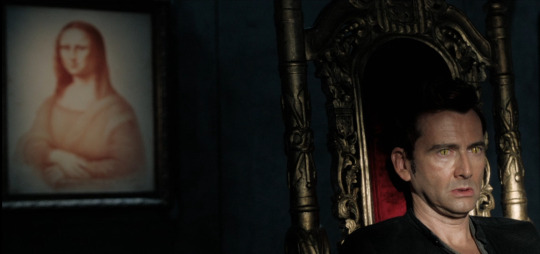
C: What? A: *somehow surprised even though HE CALLED* A-ah, hello. It's me! C: I know it's you, Aziraphale. A: *regaining composure* Yes, well, just calling to see how you were doing in lockdown.
The video starts with shots of Aziraphale and Crowley's da Vinci sketches (and some sushi remnants)... Babygirl is flipping through the time-goes-too-fast-for-me version of a facebook album, thinking about his crush. vERY chill of him. (also the paper looks new and he's eating on top of them, suggesting these are prints and he has multiple copies of them... sooo normal)
If we look closer at the still of Crowley's portrait, we can see part of the spine of a book that reads Kei- Chesterto-. This is, of course, author Gilbert Keith Chesterton, to whom Neil and Terry (and Crowley) dedicated Good Omens:
The authors would like to join the demon Crowley in dedicating this book to the memory of G. K. Chesterton A man who knew what was going on.
In this post by @azfellandco about Chesterton, you can see a photo of the dedication page and also read the book excerpt where Crowley describes Chesterton as 'the only poet in the twentieth century to even come close to the Truth'.
C: I'm bored. I'm so very very bored - transcendentally bored. There's nothing to do here!
As Crowley is explaining his nap contingency plan, we get a shot of Aziraphale picking up his mug of hot chocolate, then the image below of the 2/3rds gone bottle of Courvoisier cognac (i mean maybe he is baking with it let's not jump to conclusions), and then the stack of books beside a framed woodcut print of witches dancing with devils...


...that I used reverse image search to trace back to page 17 of a book from 1720 called The history of witches and wizards: giving a true account of all their tryals in England, Scotland, Swedeland, France, and New England; with their confession and condemnation.
Interestingly, the text above and below the picture reads:
At their Meeting they have usually Wine, or good Beer, Cakes, Meat, or the like; they Eat and Drink really: When they meet in their Bodies, Dance also, and have Musick...
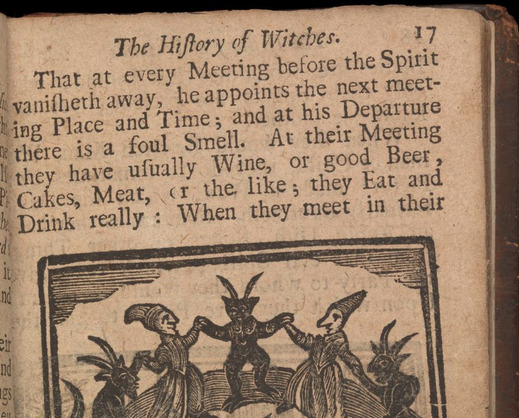

Beside the framed print of Aziraphale's idea of a really great night out is a stack of books that includes (going from top to bottom):
Homer's The Iliad, Book 2
Orthodoxy by G.K. Chesterton
Forbidden Rites: A Necromancer's Manual of the Fifteenth Century by Richard Kieckhefer
a book by Hilaire Belloc with no visible title
The Club of Queer Trades by G.K. Chesterton
The Iliad (according to sparknotes) has the following major themes:

....Interesting, ok. Book 2 in particular starts with a god (Zeus) messing with someone (Agamemnon) via a dream that says he will be successful in taking Troy if he launches a full assault, balls to the (city) wall. Agamemnon, who is supposed to be leading the Achaean army to conquer Troy, believes the dream but then in a weird twist decides to test his army and be like 'jk actually I'm giving up and going home' and then is mad when the soldiers are like 'sick, to the boats!' Then Odysseus, who sparknotes tells me is the most eloquent of the Achaeans, gives an impressive speech to inspire the troops and reminds them that they vowed 'that they would not abandon their struggle until the city fell.' ...No way that could worsen Aziraphale's internal conflict about being a bad Angel who thwarted the Great Plan. >.>; Orthodoxy we'll get to in a second.
Then there's Forbidden Rites which is a medieval necromancy guide translated from Latin with added commentary - Aziraphale is perhaps studying occult topics in an attempt to understand Crowley better? And then there's the Hilaire Belloc book on top of the second Chesterton book, a collection of related stories/episodes?, The Club of Queer Trades. The book's Wikipedia page says:
Each story in the collection is centered on a person who is making his living by some novel and extraordinary means. To gain admittance [to the Club of Queer Trades] one must have invented a unique means of earning a living and the subsequent trade being the main source of income.
Aziraphale and Crowley have rather novel/extraordinary jobs and they're both peculiar-queer and gay-queer. Neat. The narrator in the book is named Charlie "Cherub" Swinburne - also neat. >.> He goes on an adventure with his friend, a retired judge and president of the Club of Queer Trades, Basil Grant, (who Oct 2021 GoodReads reviewer Cecily said is "described as mad, mystical, and a poet, with almost no friends, but who “would talk to any one anywhere”) and Basil's younger brother, a private detective named Inspector Constable Rupert Grant. The last line of the book is:
Thus our epic ended where it had begun, like a true cycle. (something something "It starts, as it will end, with a garden.")
Anyway, the Belloc book and The Club of Queer Trades are placed back to back in such a way that they almost look like they could be one book with two different aesthetics, or... two halves of a pantomime beast?! (stay with me I needed a segue)

Belloc and Chesterton have what is essentially a ship name:

It was coined by George Bernard Shaw (if you are like me and didn't know why you've heard of him: he wrote, among other things, Pygmalion, which was adapted into My Fair Lady). Shaw apparently liked to gossip about Belloc and Chesterton with H.G. Wells (again if you're uncultured like me: he wrote, among other science fiction-y things, The War of the Worlds).
In the Feb 15, 1908 issue of The New Age newspaper, Shaw said:

He continued:
"Chesterton and Belloc are so unlike that they get frightfully into one another’s way. ... They are unlike in everything except the specific literary genius and delight in play-acting that is common to them, and that threw them into one another’s arms.”
Shaw says Belloc is 'a bit of a rowdy', and 'cannot bear isolation'. Hmm. Then he says Chesterton is 'friendly, easy-going, unaffected, gentle, magnanimous, and genuinely democratic'. HMM.
“They share one failing—almost the only specific trait they have in common except their literary talent. That failing is, I grieve to say, addiction to the pleasures of the table.”
Ok ok I think we can see where this is going.
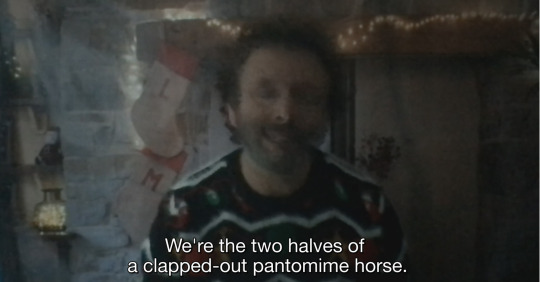
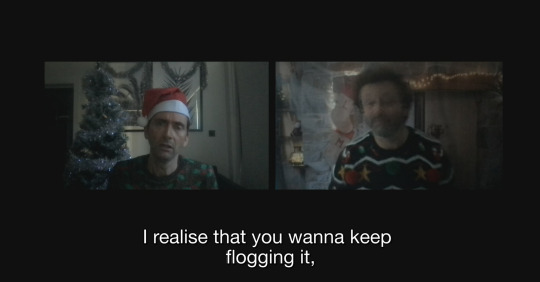
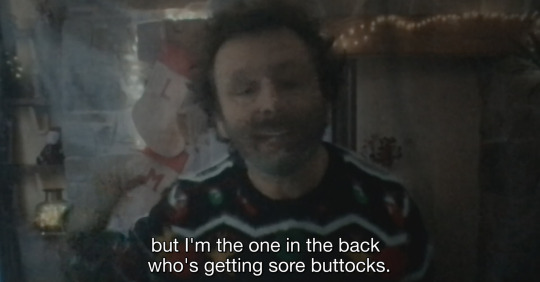
(^ from Staged S3E6)
Now, someone did ask Neil Gaiman about this similarity, and he said the Lockdown video was filmed by Rob Wilkins in Terry Pratchett's library, and that he suspects 'Belloc is there because he was on Terry's shelves beside Chesterton.' And it MAY VERY WELL BE that NONE (0) of the book titles are meant in any way other than 'these are books from Sir Pratchett's library that looked nice on camera and ofc we wanted some Chesterton refs and maybe some demon-y stuff for Crowley' but that is WAY less fun so I am choosing to take them as intentional: these are books Aziraphale is actually reading (along with the sushi and many cakes he is actually eating). Let's put ourselves in Aziraphale's shoes and try to imagine how it would be to read this stuff during lockdown while you pine for a demon with slinky hips after you got in big trouble at work for Armageddoff (and work happens to have defined your worldview and general purpose in life).
C: welll... ngk then people might follow my bad example and get ill. Or even die—
As Crowley acknowledges that he ought to be out making peoples' lives worse, we see Orthodoxy by Chesterton open on the desk.
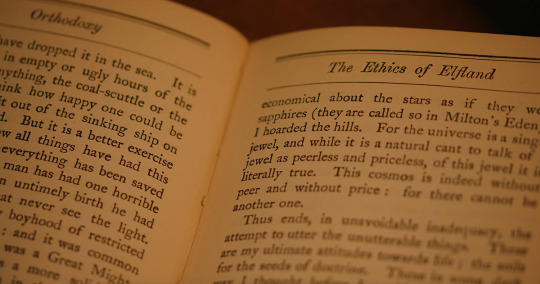
Orthodoxy is described as a ‘spiritual autobiography’ and is considered a classic of Christian apologetics, i.e. the religious discipline of defending religious doctrines (in this case, Catholic) through systematic argumentation and discourse. Wikipedia also says Chesterton's The Everlasting Man contributed to C.S. Lewis' conversion to Christianity, so overall it sounds like he must've been fairly convincing. (and so maybe reading it also poked at that work-related-but-religious-trauma-adjacent stuff Aziraphale has going on?)
You can read Orthodoxy (and probably any of the books I mention bc theyre all old) on project gutenberg but I will include this part of what is shown on the righthand page bc it just reminds me (and so probably Azirapalala as well) of a certain angel squeaking happily at a nebula:
"I felt economical about the stars as if they were sapphires (they are called so in Milton's Eden): I hoarded the hills. For the universe is a single jewel, and while it is a natural cant to talk of a jewel as peerless and priceless, of this jewel it is literally true. This cosmos is indeed without peer and without price: for there cannot be another one."
Ok great, so Aziraphale is diving into the works of one of Crowley's favorite authors bc he misses him, that's cute. What else? Oh he already wrote him a letter right before calling - THE WICK ON THE WAX STICK FOR THE SEAL IS STILL SMOKING. sO CASUAL asdashgfjds
something something 'either call on the phone and talk, or appear mysteriously; don't do both'


When Aziraphale gets to 'I've never had so few customers, not in two hundred years!' We get a close up of this glass of cognac with droplets still on the side — I take back what I said about baking, Aziraphale is drinking it~
He's not drinking a wine, eg Châteauneuf-du-pape, which would be ~14% alcohol by volume (ABV), or a sherry (15-20% ABV); he is drinking Courvoisier cognac, a hard liquor (40% ABV). Crowley's Talisker whisky is 48.5% while we are on the topic. This is stronger than what Aziraphale usually drinks which means... he could be a bit tipsy.
As Aziraphale starts talking about the would-be cash-box burglary, we get this wide shot of the desk:

In the top left hand corner, we see two stacks of books, most (all?) of which appear to be Chesterton when I zoom in. Some of them have Chesterton's name visible on them, others have the publisher name 'Darwen Finlayson' on them, which according to my googling is a house that published several of Chesterton's works. If Chesterton was truly 'a man who knew what was going on', then perhaps this is Aziraphale seeking not just to feel closer to Crowley, but also to make sense of the warring ideas in his mind. Interestingly, Chesterton has also been described as 'The Eccentric Prince of Paradox'.
C: *clearly amused* Did you smite them with your wroth?
The screen then shows two occult-y books and a flickering candle (lower left image). Then Aziraphale explains about his cake~, and as Crowley cuts him off because he's about to nervously ask to come over bc he is so so lonely & down bad for a certain angelic bookworm, we see a map of Oxfordshire on top of Pilgrim's Progress (lower right image).
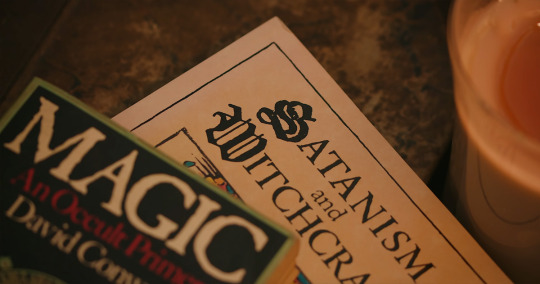

The two books beside the candle are Satanism and Witchcraft (presumably the 1862 book by Jules Michelet that comes up when I search the title), and another called Magic: An Occult Primer.
Satanism and Witchcraft is described on Wikipedia as 'notable for being one of the first sympathetic histories of witchcraft' and says 'Michelet was one of the first few people to attempt to show the sociological explanation of the Witch Trials.’ Sympathy for people who like to eat/drink/dance with demons, if you will?
Magic: An Occult Primer is a 1972 book by David Conway, a Welsh (CACHU HWCH!) magus and is described as 'a seminal work that brought magical training to the every-magician'. It also includes an appendix called The Occult Who's Who, which is somewhat reminiscent of Hastur's Furfur's book about angels. In Chapter 11: A Word About Demons, it says in regard to summoning them:

"Assuming that the form has turned up in the right place, it will soon begin to act and talk in a very friendly manner; do not forget, however, that its winning ways conceal a sinister intention-- namely, to get the adept out of the circle, and into its clutches.”
...okay?? Aziraphale's desk has a flickering candle on it throughout the video, and we get a close up of the flame when Crowley offers to slither over:
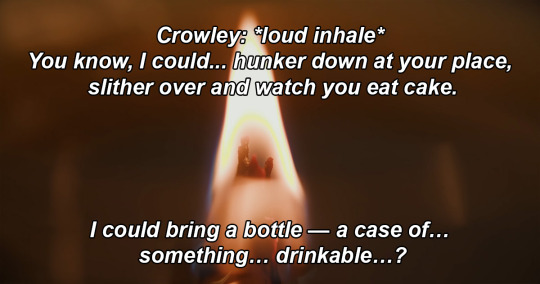
and just like that, Aziraphale has summoned a demon~~
Naturally, he freaks out:
A: *panicking*Oh I— I— I— I— I'm afraid that would be Breaking All The Rules! *nervous breathing* Out of the question! I'll see you… when this is over.
But why? Isn't this what he wanted? Let's go back to the Pilgrim's Progress shot from right before the successful demon summoning and zoom in:

In a similar vein to Orthodoxy, Pilgrim's Progress, by John Bunyan, is an allegorical Puritan conversion narrative. Christian is the main character / stand in for anyone who wants to be in the allegory and Hopeful is well, hopeful, from what I gather. A slightly larger continuous excerpt is here for the curious, but here are some bits I thought were especially interesting in the part of the book shown above:
Christian: Why, what was it that brought your sins to mind again? Hopeful: Many things; as, If I did but meet a good man in the streets; or, If I have heard any read in the Bible; or, If mine head did begin to ache; or, If I were told that some of my neighbors were sick; or, If I heard the bell toll for some that were dead; or, If I thought of dying myself; or, If I heard that sudden death happened to others; But especially when I thought of myself that I must quickly come to judgment.
Perhaps the pandemic is bringing Aziraphale's "sins" to mind again, on top of the whole choosing faces thing to avoid 'quickly coming to judgment'. And then:
Hopeful: I thought I must endeavor to mend my life; for else, thought I, I am sure to be lost forever. Christian: And did you endeavor to mend? Hopeful: Yes, and fled from not only my sins, but sinful company too, and betook me to religious duties, as praying, reading, weeping for sin, speaking truth to my neighbors, etc.
UM??? While I can't say about the praying or weeping for sin, he has definitely been reading and the whole 'giving a good talking to' the burglars could be 'speaking truth to [the] neighbors'...?
Anyway to recap:
Aziraphale has been poring over books about dark magic and demons as well as a ton of books by an author that Crowley loves and who formed a partnership w a very different person in a sort of yin-yang, pantomime beast situation
He has been looking at pictures that remind him of their fun times w Leo in Florence and eating sushi and cake cake cake (and forgiving sinners) and drinking hot chocolate and cognac trying to fill a void but now he's tipsy so he wrote Crowley a letter, stamped it with a wax seal and then thought 'I should call her' BUT
His recent brush with attempted death penalties, the death toll of the pandemic, and some of the religious books he was reading have also filled him with guilt/fear over disobeying Heaven, who he knows could still be watching him and Crowley, so he feels much more conflicted than usual AND
He probably has some inkling that he wants to go ape shit on that ox rib if it comes over to hang out (lol editing to add bc i remembered ox rib discourse: ape shit in an emotional way! whether you hc them as ace or not I just think he really likes him and I’m using ox ribs as a stand in for general forbidden joy/love, not specifically sexy stuff)
So he has to say no.
Anything else might cause him to spontaneously discorporate into a plume of pining and cognitively dissonant gay smoke, which may be all well and good if you only think there's a God, but if you KNOW it and the angels are absolutely recording you and Heaven just tried to kill you and your wife colleague, it's... kind of a big deal.
C: Right. gnnehh. I'm setting the alarm clock for July. Good night, angel. *dial tone*
We don't get to hear Aziraphale's response, but besties you and I both know he is not feeling tickety-boo. He spent like a month putting off calling Crowley (UK lockdowns started end of March, the call is at the beginning of May), finally got drunk and said what the Hell, it'll just be a fun flirty chat in between his temptations, and then it turned out Crowley was depressed and not going anywhere and Aziraphale made him even sadder. And then it got worse because it wasn't all over in July, or in October, even.
I think Aziraphale ends up with a lot of time and brain space in which to think about how Orthodoxy and Pilgrim's Progress were only written to guide *mortals* and how it really wouldn't be so bad if he spent more time with Crowley, would it? Heaven hasn't reached out in actual years again, things feel safer. Crowley is essentially Good and spending time with him would be sort of ministering to the downtrodden and afflicted, and Aziraphale does miss reporting his good deeds (lol you know, whatever rationalizations you need to get you there).
More than anything, he thinks about how hollow everything feels without Crowley; how no mouthful of food or drink tastes as satisfying in his absence because it wasn't ever just about the 'gross matter'...
So when lockdowns end, Aziraphale begins to summon his demon again, but this time with much less inner struggling. It all comes so naturally, when you let it. By the beginning of Season 2 in 2023, they seem delightfully comfortable with their shared routines and places (see also this lovely post by @nightgoodomens). Our car. Our bookshop.
Aziraphale might take longer to catch up, but he does get there.
(SHHH DON'T THINK ABOUT EPISODE 6! STOP! I'M HANGING UP!)


“The way to love anything is to realize that it may be lost.” ― G.K. Chesterton
#good omens meta#good omens analysis#good omens#ineffable husbands#good omens lockdown#ineffable idiots#IF YOU READ TO THE END ILYSM but you're probably sitting like a shrimp now so please stretch and hydrate <3#i've connected the dots#(you haven't connected shit)#maybe i created the dots myself but i connected them#lol i essentially wrote a fixit meta bc the first meta was so sad#long reads#neil gaiman#rob wilkins#tw alcohol#g. k. chesterton#hilaire belloc#the chesterbelloc#aziraphale fumbling a bitch so damn hard#michael sheen's clapped-out sore buttocks
334 notes
·
View notes
Text
My thoughts on AQPDO

So, did this image appear in the actual film? Yeah, that's what I thought...
I loved it, and I was disappointed by it. This is long, so buckle in. Major Spoilers discussed below.
First, the outstanding: the performances. Holy hell. Lupita. Just...her talent is breathtaking. To sustain that level of intensity without overdoing it, I am simply in awe. Well done. I hope some attention is paid to her performance when award season rolls around. Ditto Alex Wolff. He did a LOT with so little screentime. Djimon too; they all were so, so moving.
Joe was so heartbreaking, and yet Joe's character is one of the things I am disappointed about, because I needed more. Not because I love Joe, but because the story needed it. I know there was a backstory that was cut, and to be honest I don't think that was necessarily a poor decision, but the issue is it was cut late in the creative process, versus in the writing, and that is where the problem is. More on that in a bit, but Joe delivered a sensitive and moving performance, and really understated as well. Not a bit of the cheeky Joe we have come to love so much that also I think pops out in Eddie and Michael occasionally. He was wholly immersed in Eric's reality and his energy complimented Lupita's so well; you can see how much they worked off each other. Dare I say she elevated his game. Another marathon performance and I can imagine how exhausting it must be to sustain that.
Second, Michael Sarnoski, hats off to you sir. The pacing, the way you put the story together visually, your heartbreaking script, just so well done. I hope they release the shooting script because I would love to read it and see the words (or lack of) that Joe and Lupita interpreted so movingly. I wonder if Michael has processed the death of a parent recently, because I felt so much emotion from this story. This film is about accepting the inevitability of death, while going through the five stages of grief, yet seeking to live fully regardless. Trigger warning: DO NOT see this movie if you are going through a rough time with someone who is terminally ill. It will wreck you. But this film is tragically, beautifully human. To deliver that story in a Hollywood big budget action film is a hat trick. Every actor in Hollywood who wants to grow creatively should be calling their agents asking to work with Michael Sarnoski right now.
Also, shout out to the production design people. They completely suspended my disbelief that the characters weren't in New York. Set design, lighting, like I could SMELL New York. Virtual production is getting so fucking good - we're well past the Unreal Wall vistas of the Mandalorian. If you ask yourself how A24 could shoot an Iraq war movie in the pastoral hills of England this is your answer.
Now, the not so good.
Go back and watch the first and second trailers and tell me how many of those moments were in the movie. Answer: barely any.
Map claw hand? We have to get out of the city? Gay couple? Old man turning off engine? Nada.
So, was this all misdirection in the marketing, making the audience think they were coming to see a summer action movie? That's legit, trying to get butts in seats, but I have a strong feeling Michael delivered a very different movie that was hacked up in the testing process. All of those scenes probably made the movie feel 'too long', and they had to cut them back to balance the action sequences with the emotional sequences.
The helicopters overhead spelling out THEY CAN'T SWIM probably came from focus group comments where someone was like 'why didn't the aliens just cross the river and start eating people in New Jersey?' (good point). But I'll bet you they wanted to give Alex Wolff's character a more significant death in regard to Samira's emotional journey, so they reshot the scene with the old man turning off the engine and had Alex do it instead.
Also, I get the strong feeling Eric showed up in the story much earlier in the original cut of the film, and the scene with Map Claw Hand illustrates that. The big question regarding Eric is why this random sad British dude gloms on to Samira and I'm not sure they answer that question in the final cut. Joe absolutely sells it, but it doesn't make sense and I suspect it's because it wasn't written that way.
Also, and call me crazy, but I think Joe is wearing a wig in some parts of this movie and not in other parts. It would make sense if there were significant reshoots based on early testing of the film. I wonder if the Alien Lava Tiki Bar (what...was that actually) scene was added later. Like, I get why Eric went up there- actually I don't, I think Eric would have been focused on getting the medicine back to her and wouldn't have taken a detour up scaffolding to follow I cat at all, but that's just me.
Finally, let's talk about the cat. Both Schnitzel and Nico are exquisite and enjoyable to watch, though how no one got scratched or bitten by a disgruntled feline is a mystery. We had a long debate about whether The Cat Represents Samira's Life, or The Cat is An Angel, or Fate, but ultimately we just went with KITTY and that made the story more enjoyable.
Samira is on a quest, to die on her terms, and once she accepts her fate, she sheds the things that no longer matter to her, and in the process gives Eric a purpose. The scene in the jazz bar was so moving. The final shot is also incredibly moving, and I hope the city was filled with the sound of music one last time, a beautiful elegy accompanying her soul to heaven.
Bravo.
#aqpdo#paloma answers#paloma review#michael sarnoski#lupita nyong'o#joseph quinn#djimon hounsou#alex wolff#schnitzel and nico#a quiet place day one
46 notes
·
View notes
Note
I've always kinda wanted to know how your versions are similar/different from the ogs, story wise i mean! you already have wonderfully different visual designs! you've probably talked about some of their stories before I probably just missed it (´-﹏-`;)
I have talked about their backstories, there on this blog somewhere. I don’t know which version of the rogues to compare them to though. I’ll just give a brief summary.
Edward: hosts a game show for his crimes, very book smart (trivia), cringe fail, divorced
Jervis: looking for his childhood friend Alice, invented a dream machine at Wayne Tech, trapped in a wonderland dream while awake
Scarecrow: parents were both doctors, murdered his father after mother’s death, worked at Arkham as a psychologist, special connection to crows since childhood
Arnold: worked on a puppet tv show, detective scare face tried to solve a real murder on set, now they interfere with police investigations for blackmail and other gain
Babydoll: I think she’ll be the same as BTAS
Joker: professional clown that never laughed, the circus collapsed/burned which he found hilarious, unsure of where the joker toxin comes in
Poison Ivy: plant scientist, got her DNA altered after a lab accident, becomes a carnivore, has a vendetta against humans
Harley Quinn: therapist in Arkham, wanted a silly fun lifestyle, humdrum until she met Joker, they become best friends, joker toxin unsure??
Catwoman: lives on the streets, wanted to be a magical girl since childhood, steals from the rich and gives to the poor
Polkadot man: experimented on since childhood to gain superpowers, mother wanted him to be a hero, perpetually sick due to alien parasites (dots), currently quarantined in Amanda Waller’s facility
Bookworm: works at public library, funding cut and threaded to close, other options didn’t work so he resorted to crime for money, anger issues
Mad mod: British fashion designer, kept mod fashion alive, thinks he deserves to be queen of England, inspired by Teen Titans episode “revolution”
Calculator: college student, major in robotics and computer science, main character syndrome, loves mecha anime, making his own mech suit (the calculator)
Hugo Strange: works at Arkham in pharmacy, regularly mixes medicine and creates something new, random patients fall victim to testing them, original creator of fear toxin
Mr Freeze: scientist working in Artic lab, wife sick in Gotham hospital, neglect caused her to pass before he could find a cure
25 notes
·
View notes
Text
Candlestick of God
by Adam Kenichi Wekarski

As one who has been completely fascinated by the actual reality of Nuclear Warfare (since my childhood), I have always found the creation of the Atomic Bomb to be the most important moment in all of human history (with exception of the actual beginning & origin of humanity & all of existence itself).
Christopher Nolan’s perfect film, “Oppenheimer”, is a significantly honorable & highly-sophisticated masterpiece that provides a cinematic insight into the individuals who were instrumental in the real life happenings of the theoretical design, creation, and eventual utilization of atomic power (as a means to an end) in one of the most defining moments in all of history.
Julius Robert Oppenheimer (portrayed Perfectly by Cillian Murphy in his finest performance) is the main focus of Nolan’s awe-inspiring cinematic achievement. Often considered to be “The Father of The Atomic Bomb”, J. Robert Oppenheimer (known commonly among his peers, family, and friends simply as, “Robert” and/or “Oppie”) was born in a Jewish household in New York City, New York, U.S.A. on April 22nd, 1904.
Born of a painter (Ella Oppenheimer/Mother) & textile importer (Julius Seligmann Oppenheimer/Father, respectively), J. Robert Oppenheimer is portrayed in the beginning of Nolan’s work as one who has an inherent appreciation for the beauty of artwork (in a somewhat subtle manner), showcased in a rather pensive moment in the beginning of the film (a moment slightly reminiscent of the end of the museum sequence in the American classic, “Ferris Bueller’s Day Off”; perhaps a deliberate cinematic nod). While the initial years of Oppenheimer’s life are not the main focus of this picture (Written & Directed Perfectly by Christopher Nolan), the film itself is based off a biographical book entitled, “American Prometheus: The Triumph and Tragedy of J. Robert Oppenheimer” (a monumental literary undertaking in it’s own right; championed by Martin J. Sherwin & Kai Bird, respectively).
Although the book is based on Oppenheimer’s life’s work (among other things), the film is a three-hour-epic which tells a tale of various meanings:
Firstly, the life of J. Robert Oppenheimer, which picks up in this film at the time of his initial years of his scientific legacy, as a student at The University of Cambridge (in Cambridge, England). In his academic years, Oppenheimer was not regarded with favor on the behalf of his scientific community. He had humbling beginnings in the scientific field, regardless of his inherent genius (which he would continue to enthrall himself in his own time). A particularly disturbing, yet accurate, moment in the film occurs when Oppenheimer actually attempts to poison his own instructor due to his considerable dissatisfaction of his experiences at Cambridge (without spoiling the story, this obviously does not come to fruition).
What does come to fruition, however, is the continual movement of subatomic & atomic particles working within the inner-structure of the mind (and overall being) of one J. Robert Oppenheimer (while he continues his pursuit of higher learning & his genuine love for all things astrophysical & theoretical science). Christopher Nolan’s film has a perfect ability of providing a visual interpretation of various scientific theories (whether it be conceptual or experimental) all-the-while providing a visual display of the deeply conflicted characterization of Oppenheimer himself throughout the entirety of his journey (via Murphy’s award-worthy performance). The cinematography of the film Oppenheimer is absolutely perfect (showcasing the undeniable superiority of film versus digital photography). The beauty of the picture is matched by moments of visceral intimacy (going in and out of focus at times with confidence) as well as larger-than-life & monumentally jaw-dropping imagery (especially during “The Trinity Test”). The musical score composed by Ludwig Göransson is a true work of genius as it creates an experimental (and highly profound & meaningful) atmosphere that helps shape the cinematic world within the film “Oppenheimer.” Göransson’s score is a refreshingly beautiful balance of symphonic & orchestral instrumentation while incorporating a tasteful implementation of electronic & synthetic instrumentation to balance the overall structure of the film. As Oppenheimer’s innermost thoughts & flashes of brilliance are scattered across the picture throughout the entirety of the story (with visual flair & editing mystique in a nonlinear method, indicative of Nolan’s directorial style), the musical score accommodates the plot & picture perfectly with a sincerely divine grace & power.
While speaking on power, the notion of atomic & nuclear power is the driving undercurrent of the film’s main protagonist as the story unfolds. As the theoretical possibilities are literally astronomical within the understanding of Oppenheimer’s significantly educated mind (as he displays a fascination for existence at cosmological proportions) - the threat of nuclear weapons being constructed and crafted by the dark forces of Fascism (by Hitler & The Nazis) halfway across the world is the other driving undercurrent of the film’s plot and main characters (all of whom, in real life, did actually place their lives on the line for the sake of our world). The known reality that the Nazis of Germany & Austria (of old) had already devised their own plan to have the ultimate weapon to command their own will over the will of others (as their invasion of Poland was merely a first step in their agenda) was not far from Oppenheimer’s mind as well as the many key individuals of whom had not only shared time with him in his life, but had become spiritual warriors of the cause to stop (once and for all) the unGodly atrocities birthed from the minds of actual evil in Nazi-era Germany.
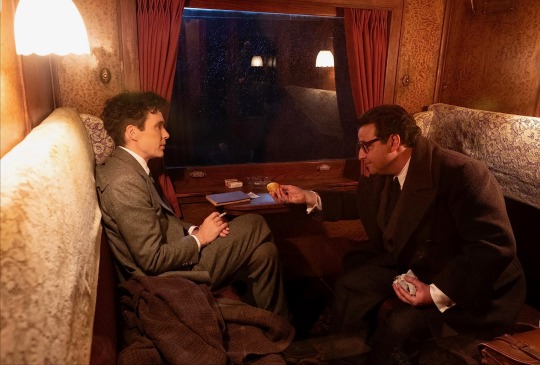
Key individuals had indeed entered Oppenheimer’s life; individuals like Isidor Rabi (portrayed gracefully by David Krumholtz in his finest performance on screen to date), Ernest Lawrence (portrayed very impressively by Josh Hartnett in his finest performance yet), Lewis Strauss (portrayed masterfully by one Robert Downey, Jr. in his greatest performance since “Chaplin”), Jean Tatlock (portrayed strongly by Florence Pugh in a highly provocative & deeply off-putting performance), Leslie Groves (portrayed incredibly by Matt Damon in my favorite on-screen performance by him since “Good Will Hunting”), Katherine “Kitty” Harris (who would later become Katherine “Kitty” Oppenheimer in real life and in the film; portrayed Perfectly by Emily Blunt in one of my favorite performances in the entire film), as well as many, many other key individuals who played significant roles in the organization of the atomic bomb in order to end what had become known worldwide as “The Axis of Evil” in [accurate] historical documentation.
The countless individuals who shall remain in the history books as having been directly associated with the formation of the U.S. Military effort (not to mention Canada and The United Kingdom, respectively) to create the Atomic Bomb are represented with dignified refinement in Christopher Nolan’s masterwork, “Oppenheimer.” The ensemble cast is enormous, and no one single performance can be understated by any other performance. Every performer on camera honorably captures an accurate portrayal of the manner of which these real life individuals had lived (granted with a dramatic tone mostly reminiscent in any major motion picture’s cinematic retelling of any major historical world event to connect an overall thought to anyone of whom views the picture).
In addition to the enormous ensemble cast is the enormous production design of the film. It’s particularly astounding to observe how Oppenheimer had become involved in the most important government protocol known to modern society, and then had the most important responsibility of practically producing a space within the nation to run highly-classified government operatives & lead numerous scientists (of both men and women) to create something that had never been physically manifested before by anyone. Cillian Murphy’s charming on-screen dynamics with his peers & colleagues (even among some of the most fascinating & completely serious situations; i.e. The personal politics becoming an element of interference & conflict even among the very people who worked as a team to construct the nuclear solution to the atomic problem; the complete classification of his work due to the priority of the U.S. Military; the priority of national security; his overall personal relationships while putting a new team of scientists together to perform the most massive scientific undertaking in a race against evil) - is just as organic as it is compelling to observe on film.
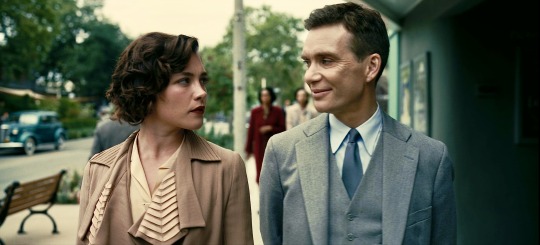
The reality of Oppenheimer’s associations with the Communist Party (as well as his own family members and friends) are presented very clearly throughout the entire film. Regardless of the numerous verbal warnings from fellow scientists such as Ernest Lawrence to keep politics outside of the laboratory (due to Oppenheimer’s rather open and highly vocal political opinions in favor for the Communist ideals with an intensely pro-worker stance), Oppenheimer continued to struggle to find the balance between his own personal convictions & morals as an individual as well as working within the functioning realm of national loyalty & honorable servitude. As the film continues into the development of Oppenheimer’s leadership as an instructor for his own students (which continues to increase in numbers), he eventually calls upon the brightest and most capable minds within his field to join the cause of stopping the world from being totally annihilated by the forces of darkness (as the Nazi army had continued to murder & genocide countless innocent lives in Europe on a daily basis and intended on dominating the world by total violence & mass genocide).
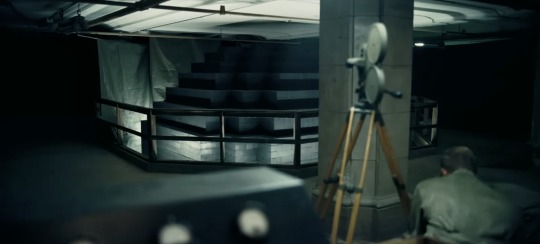
With a newly formed team and his continued work alongside Leslie Groves (a true man of the cause; a decorated Engineer of the U.S. Military who did his service to his country with much Pride & Honor) to build a physical location to perform what would later be referred to as “The Manhattan Project” (which was a perfect recreation in terms of production design of the classified military operation in Los Alamos, New Mexico, U.S.A.), Oppenheimer’s vision had come to fruition in the most tangible form (with the relentlessness of Groves throughout the entirety of the nuclear arms race). After the painstaking search for the perfect team to create the most destructive force known to humankind was completed (even with a briefly elusive encounter between Oppenheimer & Albert Einstein [portrayed by Tom Conti with awe-inspiring perfection & grace] in the beginning of the film when Strauss extends an invitation to Oppenheimer), the increase of scientific gravitas becomes ever more present with each scene in the film and each additional scientist of whom helps construct “the weapon to end all wars.” With each additional individual who presents more & more ideas to the table (so-to-speak) on how to successfully achieve the most effective scientific results (during an intimate look inside the American think-tank that constructed the weaponization of atomic power), the collaborative efforts put forth by the men and women who built the atomic bomb was frequently rife with conflict & tremendous disagreement due to the meeting of massive minds (often harboring massive ideas & massive egos to boot).
The potential security threat that Oppenheimer’s Communist ties initially raised had been dissolved by Leslie Groves due to his concrete belief in Oppenheimer’s intellectual abilities as a Scientist. This clear confidence, regardless of personal reservations, is what prompts Robert Oppenheimer’s brother, Frank Oppenheimer (portrayed respectably by Dylan Arnold) to join the highly classified government operation to defeat the Nazis in the race for atomic power (regardless of his clear ties with the Communist Party). The cause had become greater than us all as our personal politics and personal reservations regarding who did [or did not] pose a potential security threat to our nation had been placed as a postponed priority during a race against time (and an actual race against evil). Just as it has always been (in regards to the most important moments in human history), desperate times called for desperate measures. This is the compelling beauty of the unified cooperation & sincere teamwork that had actually happened in real life with real human beings who truly did save the world from the further influence of the destructive forces of darkness (and our absolute end as an overall existence). Regardless of differing political ideologies, many individuals came together for the common cause to stop the world from succumbing to the most sinister darkness ever known to be (by collectively constructing a proverbial candlestick of God to bring forth from the heavens the ultimate force of light).

Secondly, “Oppenheimer” is a picture about the tragic betrayal & political persecution of J. Robert Oppenheimer despite his awe-inspiring commitment & loyalty to The United States of America as a government and as a nation (as well as the entirety of humanity and existence on Earth). The second act of this three-act work of art is primarily focused around the McCarthy-era “Red Scare” that occurred in America that followed the aftermath of the end of World War II in the following decade. The Red Scare had essentially been a witch-hunt in contemporary America for anyone who was a Communist, held affiliations with the Communist Party, or was suspected of having potential connections and/or ties with any individual(s) or organization(s) associated or in some way, shape, or form, and/or of having any relations with Communism as a whole (very reminiscent of another important socio-political picture focused on the era of McCarthyism in America entitled, “Good Night and Good Luck”).
Regardless of Oppenheimer’s complete commitment & sincere dedication to the cause of our great nation, he was still held under a severe amount of scrutiny and political punishment for his past associations with the Communist Party. In addition to a public hearing which had placed his entire scientific credibility & honor as a man under an unnecessary humiliation that attempted to destroy his life, family, and career - He also faced a significant amount of antagonistic questioning on a daily basis regarding a tapestry of arbitrary & meaningless questions that were implemented more severely & viciously with each passing day in order to further diminish, attack, and otherwise destroy his character (regardless of him & his family’s sacrifice for the greater good).
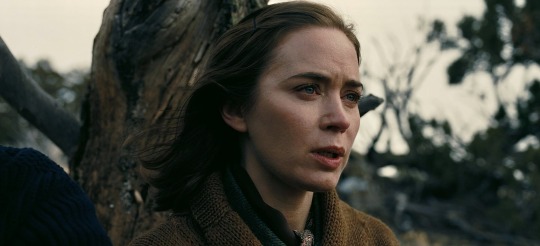
The second act is duplicitous in the sense that it’s nonlinear in it’s presentation (similar to the earlier work by Nolan, “Memento”). Act two is primarily in black & white, a clear indication of the nature of the duality of Oppenheimer’s scientific & humanitarian achievement in that he was once an exciting figure full of potential in the first act (with a sense of hope & color & adventure), and now the second act has him facing questions (in a stark contrast to act one) regarding his own character and his associations (in addition to the very achievement he was called upon in order to save the world from total annihilation, by the very people who asked for his help). The second act happens simultaneously with the first act which is a stroke of genius in the direction, writing, and overall production quality of the film. Without revealing too much in order to preserve the quality of the picture, the second act is a complete torment on Oppenheimer’s character and his actions and overall judgment calls (as the man responsible for having a scientific team working for the U.S. Military & U.S. Government that actually had Russian spies and double-agents infiltrating classified U.S. intelligence during The Manhattan Project and The Trinity Test). The truly unfortunate reality is that Oppenheimer, while being a genius who worked alongside many, many brilliant & wise individuals, still managed to succumb to the double-cross of individuals of whom were trusted with the highest security clearances in our own U.S. Government (while covertly operating within the means of international political subversion & government espionage).
While I will not indulge further into the premise regarding the socio-political plot-related themes of the film, I will indeed acknowledge the Kubrickian fashion in which Nolan has immersed his direction in this particular film (in all of it’s 70mm glory). Without spoiling the story for anyone; there is one scene during Oppenheimer’s questioning where the film provides a visual representation of how deeply each question had cut Oppenheimer as a person (and character). What would seem to be a completely gratuitous sex scene during Oppenheimer’s questioning (courtesy of Florence Pugh & Cillian Murphy, both in a highly artistic light), is actually an astonishing symbolic gesture that showcases the real suffering that was not only endured by Julius Oppenheimer (having been known for his illicit affairs), but also his wife, Katherine, during one of the worst times in Oppenheimer and his family’s life (which fed into Kitty’s alcoholism despite her own intellect & genius in real life). The questions of Oppenheimer’s commitment to our country, and to the greatest cause in the world, and the questioning of his personal affairs in order to smear his good name was discovered to be a deliberate method of private interest (facilitated by an individual later revealed in the film).
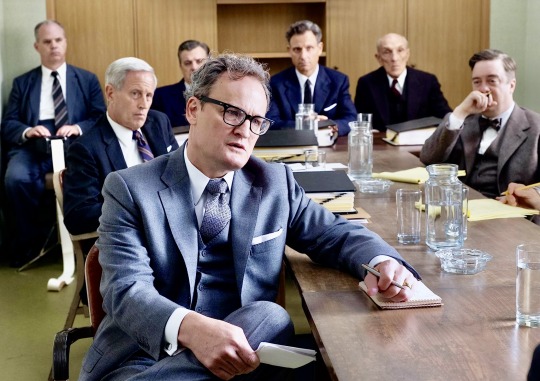
Oppenheimer’s credibility & worthiness had been completely tested, challenged, and disgraced regardless of the fact that he utilized his intellect (and the intellect of countless individuals in his immediate life that had all worked together) in order to bring an end to the forces of darkness by using the most powerful form of light: Atomic Power.
Thirdly, Christopher Nolan’s monumental cinematic achievement is, symbolically-speaking, about the Greek tragedy of the Titan known as Prometheus (originally based off of Hesiod’s ancient mythological poetry, “Theogony”; as well as the 5th Century [B.C.] epic trilogy written by Aeschylus, “Prometheia”; a trilogy of tragedy consisting of “Prōmetheús Desmótēs” (a.k.a. “Prometheus Bound”), “Promētheus Lyomenos” (a.k.a. “Prometheus Unbound”), and “Promētheús Pyrphóros” (a.k.a. “Prometheus The Bringer of Fire”). In the calculated words of Oppenheimer, himself, as he identifies with the paradigm of which confined Prometheus before him, “…I am become Death, the destroyer of worlds…” (taken from Eastern Philosophical Sanskrit spiritual text; quoting Vishnu of the Hindu faith; Bhagavad Gita, approximately 4th Century BCE). As Oppenheimer’s ability to “bring fire” to humanity (a cinematic similarity of the mythological tragedy of Prometheus), having stolen fire from Zeus and having given it to Humanity (in addition to civilization & science & knowledge from the heavens), the mythological being’s tale had become an obvious parallel to Oppenheimer in his actual waking life (when he was indeed alive on this earth and did aim to wield the power of the universal light). Regardless of Oppenheimer’s world-changing achievement (and the further harm it would prevent on a mass level), he was still able to intellectually determine his own profound understanding of the bloodshed & death that would be the result of his scientific creation (despite the necessity to stop the seemingly unstoppable armies of Germany & Japan at the time). Oppenheimer, like Prometheus before him, had successfully managed to reach for the stars and pull the light down from the heavens, and bring it to humanity on earth in order to prevent Zeus from completely obliterating and destroying humanity as a whole.
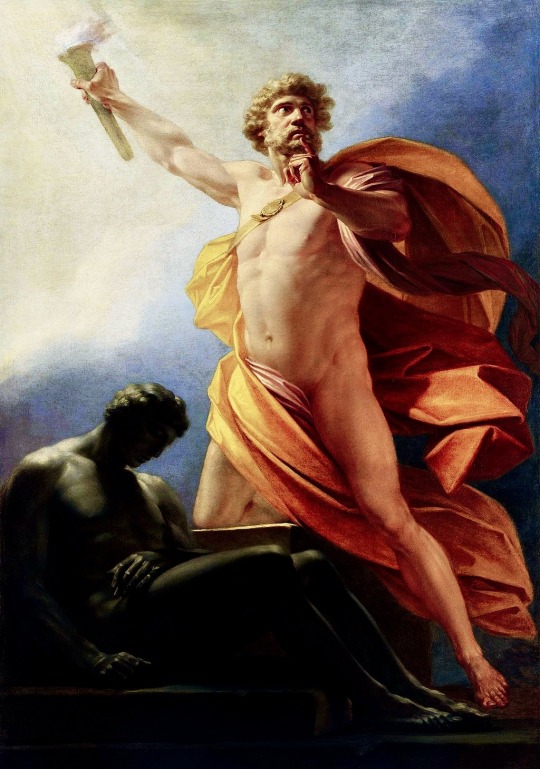
In Nolan’s masterpiece, as Prometheus had learned the ability to seize the power of fire could indeed be harnessed from the heavens, Oppenheimer had learned the ability to seize the atomic power that could actually be harnessed from existence itself (as the molecular structure of all existence as we know it is indeed a physical result of atomic activity combined with spiritual energy [individually & collectively]) within an interaction between the tangible & intangible forces of cosmic energy & matter & waves of sound.
As in the tale of Prometheus, after having brought fire to earth from the heavens, the following punishment was the eternal torture & torment of Prometheus (condemned by Zeus). Prometheus was shackled to a boulder, as his immortal liver was eaten on a daily basis (having the ability to regenerate each day) by an Eagle (typically identified as the emblem of Zeus). In a contemporary context, an eagle also identifies as a symbol of State Power; Authority of The State; Government Power. Zeus, in Nolan’s cinematic interpretation, has a much more fascinating and complex representation via two different major political figures (both Adolf Hitler as well as President Truman; the inherent duality of state power). Without giving anything away - The brief cameo of President Truman (as he and Oppenheimer meet) is an encounter similar to that of when Peter Finch’s ‘Howard Beale’ meets Ned Beatty’s ‘Arthur Jensen’ in the film “Network” (albeit more brief). While Oppenheimer’s brilliance and complete concern over the social responsibility of striving for a world where we no longer need to use any such weapons in order to remain a functioning society - President Truman (portrayed masterfully by an actor who shall remain nameless to maintain the integrity of the picture) shows the true nature of the political world by declaring the contrary and asserting a further implementation of research & development to deter any further international threats (regardless of Oppenheimer’s clear concern of any government having such access to such extensive means of weaponized methods of power on the nuclear level).
It’s a truly fascinating & monumental statement to have applied the cinematic telling of one of the most important moments in human history while simultaneously bringing forth poetic symbolism of a Greek tragedy (utilizing the most powerful form of cinematic triplicity; particularly with the utilization of Einstein who plays more like a force of nature rather than a man). The third act of the film releases Oppenheimer from his proverbial rock of eternal torment in his own modern Tartarus, as he is released by the help of the every-day scientist, David Hill (portrayed perfectly in a minor, but completely effective role by Rami Malek). As Heracles before him, Hill’s presence sheds new light on an intriguing internal development within the scientific community which not only shows the duplicitous nature of the second act, but also the duplicitous nature of the individuals of whom had called upon Oppenheimer to help create the atomic bombs that would be dropped on the civilian cities of Hiroshima & Nagasaki, Japan (respectively). Rami Malek’s brief, but significantly important role in the film is the pivotal turning point that grants Oppenheimer, his family, and his associations (both past and current) freedom from previous prejudice & extreme ridicule (in a gratifying on-screen showdown that brings forth the most important message of the entire film).
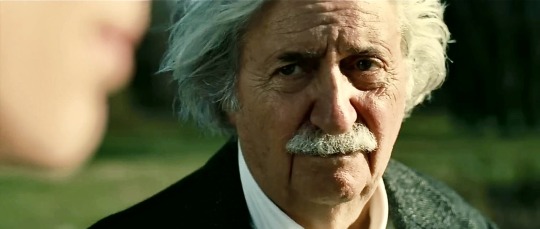
Lastly, and most importantly, the overall message of Nolan’s masterpiece is about honoring the people who deliberately rise to the occasion in order to save the good grace of humanity & the sanctity of life as we know it (regardless of prior or potential political affiliation or one’s professional ego or private interest). The importance of speaking up on the behalf of the ones who do good in the world, and celebrating each achievement in order to propel the individual (and the collective) further into the future is essential in all industries (not just the scientific field). The ones who literally step forward to save & preserve the fate of humankind & our world (by intellect, spirit, or body) should be awarded for their good faith (not punished or tortured or removed by exclusion due to the absurdity of bureaucracy or envious competitors or kicked back into the world merely as paupers, or as the film refers, a “Lowly shoe salesmen”).
In conclusion: The elusive moment between Einstein & Oppenheimer (which comes back around full circle from Act one through Act three) is a highly powerful moment on film that provides an insight into the purity of true genius & brilliance (more importantly & above all else: a wisdom that burns inside within the spirit of Oppenheimer as it had in Einstein; a candlestick of God’s light from within: All-Knowing, regardless of the tumultuous path ahead of the man that became known as “The Father of The Atomic Bomb”). The beauty of the film is not one individual’s achievement, but the collaborative achievement of the goodness of humanity as a species in order to stop the darkest evil known to humankind. It was one individual who lead a team of individuals (with unmeasurable personal & professional sacrifice on everyone’s behalf), a true human being alongside other noble human beings who did what was necessary to preserve the sanctity of life as we cherish it to be. Considering the known reality that the relevance of an actual threat of nuclear warfare still exists in our modern time (approximately one century after the real atomic bomb had been created by the most important team of individuals who placed, not only country above party, but humanity above it all), perhaps Christopher Nolan’s cinematic echo of the past will allow us all to consider the priority of humanity’s future as we look towards a better time, not just for a certain few, but for ALL of us as an entire world (now & forever).

#Oppenheimer#CillianMurphy#EmilyBlunt#MattDamon#RobertDowneyJr.#FlorencePugh#DavidKrumholtz#JoshHartnett#MatthewModine#TomConti#LudwigGöransson#HoyteVanHotema#ChristopherNolan#EmmaThomas#JuliusRobertOppenheimer#HeinrichFriedrichFüger#Movies#Film#Art#CandlestickOfGod#AdamWekarski#AWESOME#TheMostImportantMovieOfALLTIME
14 notes
·
View notes
Text
Tagged by @saltyfilmmajor! Thank you! <3
name: Sarah, I'm trying to make Genie happen on here but I'm not trying very hard pronouns: she/her in real life, online I don't really care but I will not know you mean me if you use anything else so it'll just be confusing for everyone where do you call home?: Boston, Massachusetts but also Maine so just New England favorite animal: manatee and orangutan cereal of choice: usually cinnamon toast crunch but I've had kind of a love affair with Reese's puffs recently. I usually eat a lot of cereal at once and then don't eat it again for like a year. visual, auditory, or kinesthetic learner: I'm what they call a "multi-modal learner" aka a special snowflake. I'm mostly auditory but significantly kinesthetic too, and while the tests always say I'm not visual there are very specific contexts where that's the best way for me. first pet: a hamster named Sunflower Seed (Sunny for short) unless you count fish. favorite scent: you know that smell you get when you put your face right next to the air-conditioner and inhale deeply? ...anyway, lemon. do you believe in astrology: absolutely not. I'm not even consistently able to have fun with it, most of the time it makes me grouchy. how many playlists do you have on your music service of choice: 3 on my main service (songs that I own on Apple Music) and 3 more aborted ones on Spotify (like three songs on each lol and I don't listen to them) which I hardly ever use sharpies or highlighters: highlighters, but depending what it's for, the colored sharpie are great too! song that makes you cry: I don't cry at music but No-One But You by Queen fucks me right up song that makes you happy: All You Wanna Do Is Dance by Billy Joel and finally, do you write/draw/create: yes I do!!! mostly write right now but I used to draw and I miss it
Tagging: @movietonight @orangefarmcat @majorbaby @youngpettyqueen @persianflaw @hamiltonsteele @proceduralbob @koboldkatalyst @old-wild-child @chrispineofficial @rescue-ram @imusthavebecomesomething
9 notes
·
View notes
Text
Ow my legs
LK 110: Warshington Takes Command
(pt1)(pt2)(pt3)(pt4)
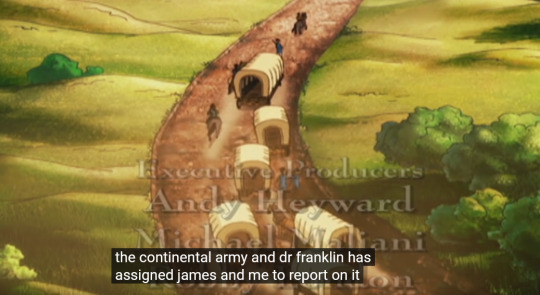
awww Sarah is so excited to be doing a journalism with her crush.
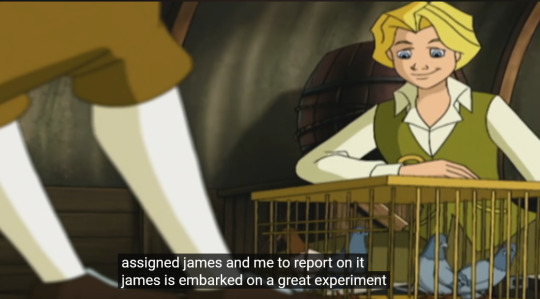
Ayyy! Its his pigeon phase!
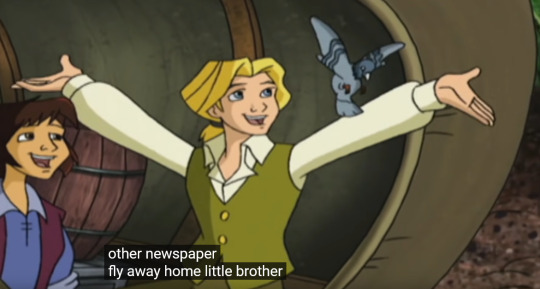
This frame has such an energy.
Also, he was kindly to pigeons as a street orphan. They kept him company while people shunned him. He is now a pigeon person.

James is so concerned for his pigeon friends. I bet he can mimic their cooing sounds.
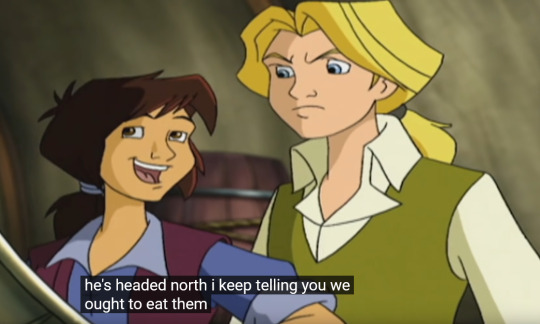
I love this interaction I love sibling interactions I love feral little sibling irritating the older sibling energy.

Dudemanbro is as unfazed by casual gunshot sounds as I now am after having grown up close enough to a base that occasionally tested artillery and would shake our windows, lived in Richmond for seven years, and then lived in a neighborhood with one person who really likes fireworks.
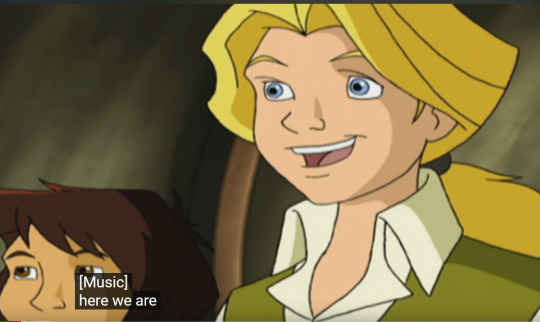
The beagle/great dane puppy is so excited.
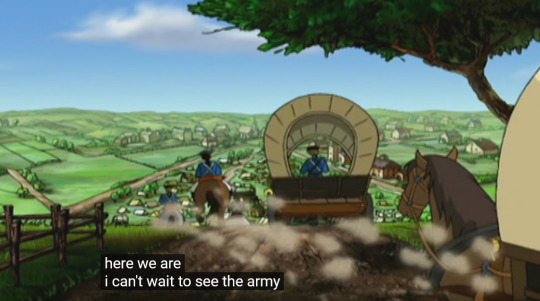
Calm down, Lydia Bennet.
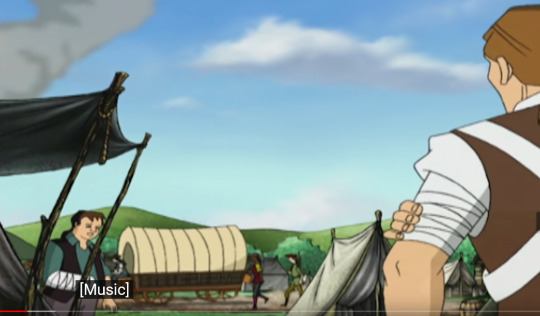
womp womp everyone's injured because war were declared.
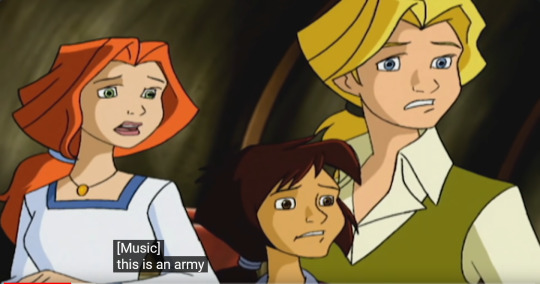
And she would know what a good one looks like!
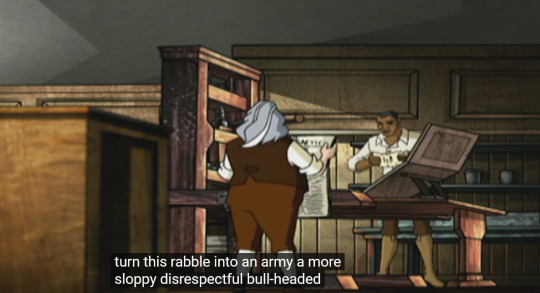
Damn James laid into them alot more than what I expected him to.
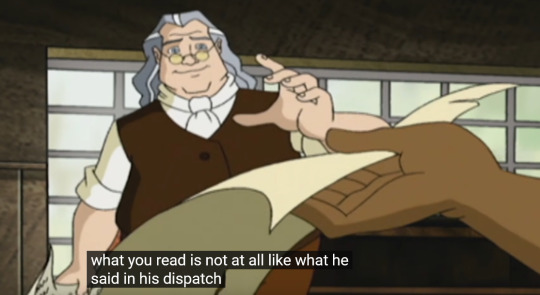
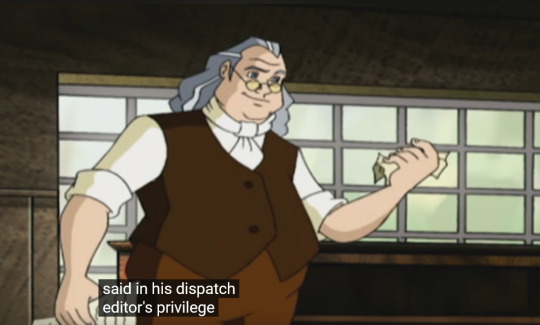
Fuckin' Yikes. Destroys the evidence.
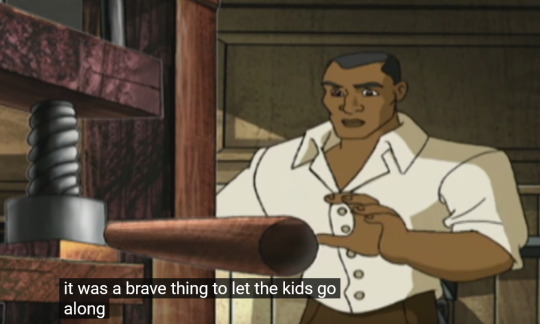
...You know I don't think it was a brave thing so much as a hare-brained, coke-nosed thing, go on though, there's a but in that sentence.
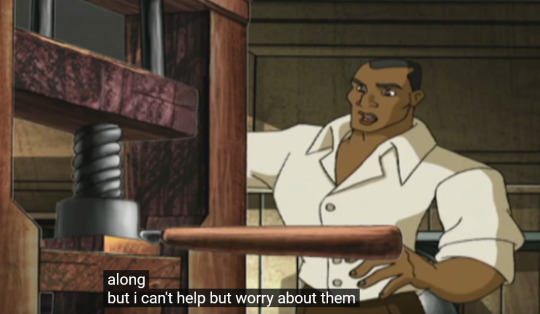
Is this Moses' extremely diplomatic way of saying Benji Franx was being a dumbass.
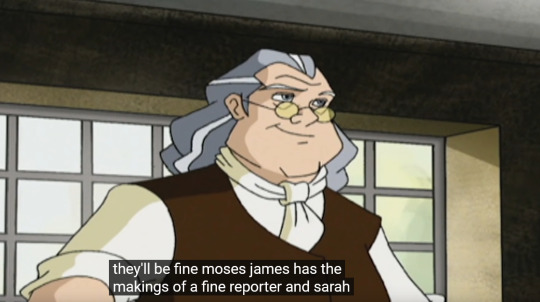
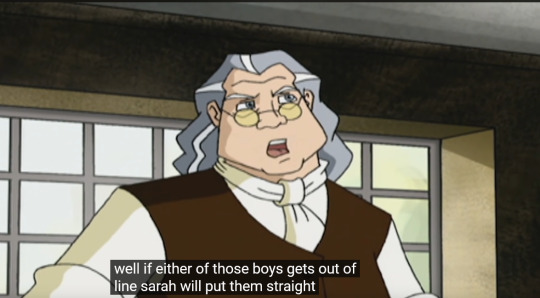
Okay but Benji, she's one of your reporters, too, and why does the girl always have to be the eye-rolling mom friend keeping the boys of the trio in line. What if its the blonde boy with main character energy that's actually supposed to be the mom friend??? He'd make a great mom friend when he isn't having ADHD teenager brain!
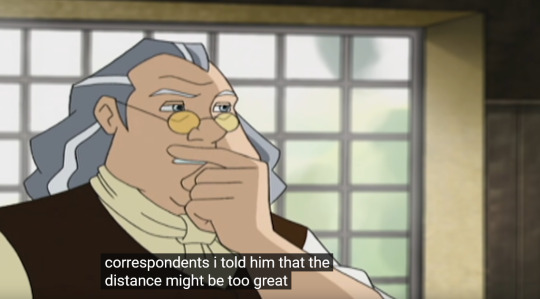
I do like the visual of James going to Franklin, excited as hell and overwhelmed that his chosen Role Model supports his Interests, and excitedly chattering/brainstorming about his idea to use homing pigeons. It was probably adorable and I wish it was shown. In this house we stan Empathetic James and Excitable James.
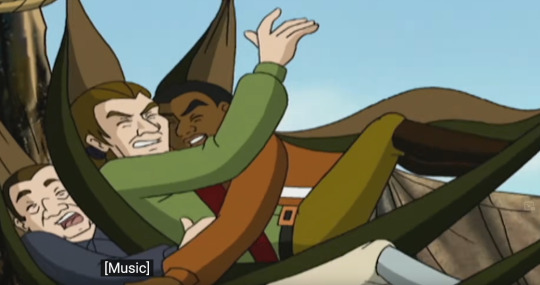
Quick someone get Lydia Bennet Sarah over here, she's missing the Army Sandwich.
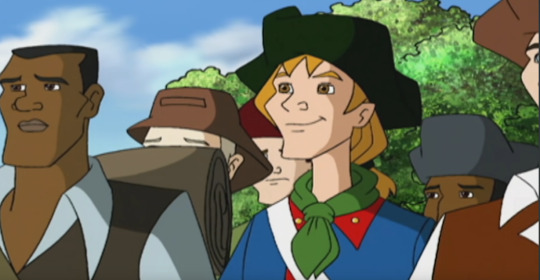
Wow this Keebler Elf really stands out. He must have been rejected by his clan for being so tall wait isn't this Aaron Carter's character

Butterfliiiiiint he must have been too clumsy with the cookie dough in Keeblerville or wherever the fuck their tree is.
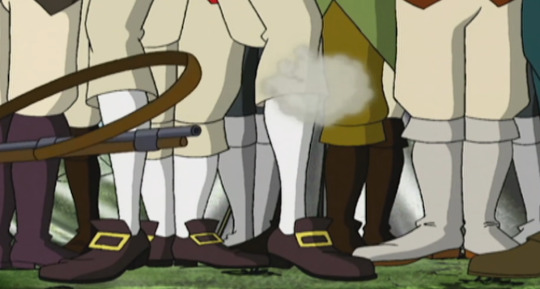
Why was it loaded, Elfo???
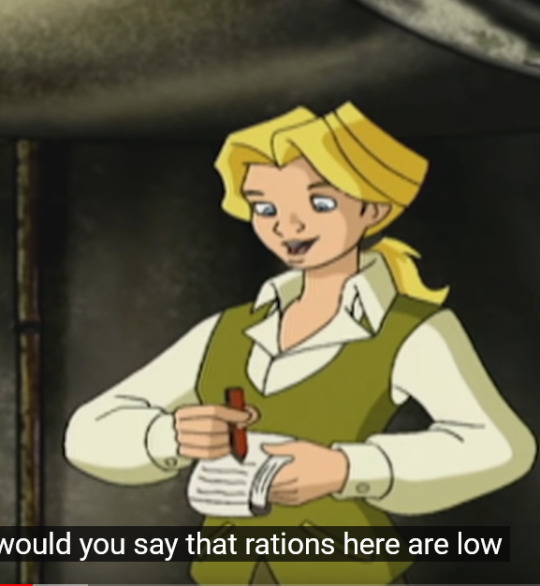
I'm very sorry, animation department, but what the hell.
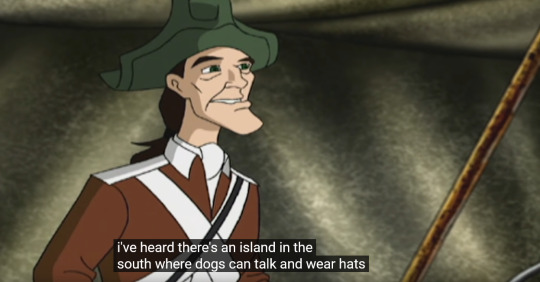
...This is a reference to some boomer shit, isn't it. I know they make a scooby-doo reference somewhere.
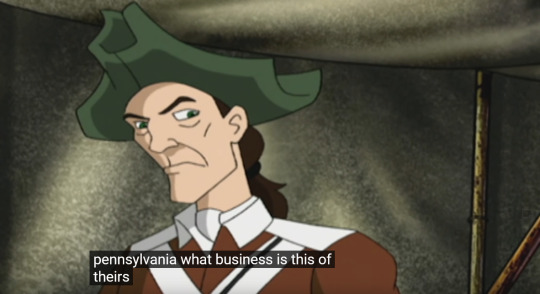
Talking mad smack for the New England version of West Virginia. What secrets is Connecticut hiding in its forests, that it so jealously guards them from Pennsylvania???? Is it the location of the Keebler Elf tree.

Colonial Walgreens Manager.
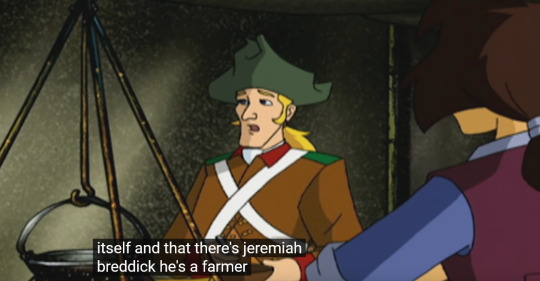
Sarrrrrge you weren't supposed to tell anyone my occupation GOSH
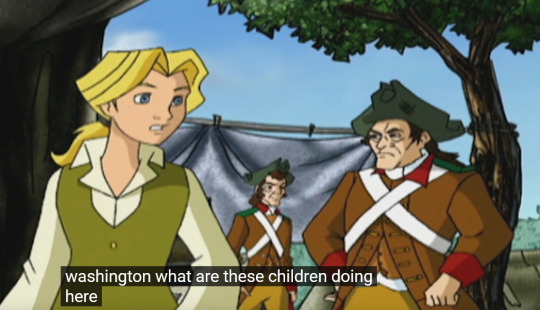
Why is this guy so ominous.
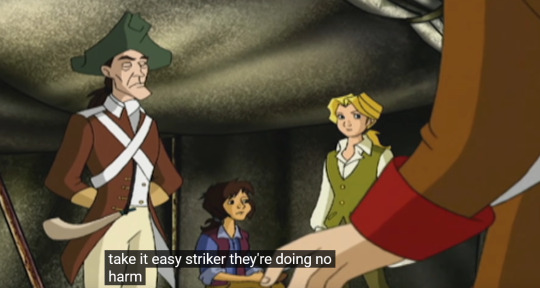
Oh my god Striker? Even his name is edgelord.
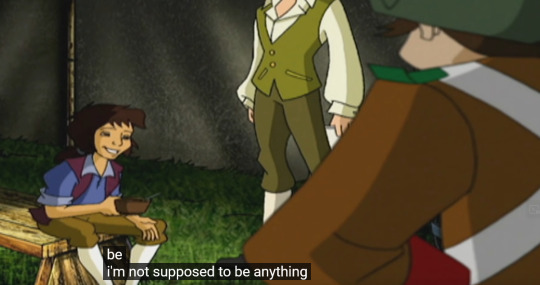
That is the correct answer, Henri!
#liberty's kids#james hiller#sarah phillips#amrev#henri lefebvre#Tricorn on the cob watches LK and makes inane commentary#tricorn watches
7 notes
·
View notes
Text
Fire Safety Regulations in Rental Properties: What Landlords and Property Managers Must Know

Fire safety is critical for anyone managing rental properties, from individual landlords to estate and block managers. With legislation evolving and the risks of non-compliance potentially catastrophic, understanding and meeting fire safety regulations is more important than ever.
At No Letting Go, we offer comprehensive fire safety inspections as part of our property reporting services. Although we don’t undertake maintenance or repairs, our function is to inspect, record, and report on fire safety compliance — assisting landlords and property professionals in maintaining legal requirements and ensuring tenants are safe.
This handbook categorises which fire safety regulation applies to the UK‘s rental sector, who is liable, and how frequent inspections can aid compliance.
Why Fire Safety Matters in the Rental Sector
Fire is one of the most significant hazards facing tenants in rented accommodation. Malfunctioning fire doors, missing alarms, and obstructed means of escape can all lead to avoidable injury or death. For landlords and managing agents, non-compliance can result in drastic financial and legal penalties, including fines, prosecutions, and damage to reputation.
By adhering to fire safety legislation and conducting regular inspections, property managers can demonstrate due diligence, ensure residents’ safety, and fulfil their legal obligations.
Key Fire Safety Legislation for Rental Properties
Several laws and regulations provide the context for fire safety in the private rented sector and block management. The most significant ones are:
The Housing Act 2004
Introduced the Housing Health and Safety Rating System (HHSRS), which lists fire hazards as one of the 29 hazards landlords need to manage.
The Smoke and Carbon Monoxide Alarm (England) Regulations 2015 (amended 2022)
It makes provision for a minimum of one smoke alarm per floor that is used as living accommodation and a carbon monoxide alarm in any room with a solid fuel appliance or gas boiler.
The Fire Safety Order 2005 (Regulatory Reform Order)
It applies to communal spaces in blocks of flats and HMOs. Responsible individuals (landlords, agents, or managing agents) must conduct a fire risk assessment and implement measures to minimize fire risks.
The Fire Safety (England) Regulations 2022
Enforced since 23 January 2023, bringing with it new duties for maintaining fire doors and fire safety systems in multi-occupied residential buildings above 11 metres in height.
Responsibilities of Landlords and Block Managers
For single-let properties, landlords are required to:
Fit working smoke alarms on each floor.
Fit carbon monoxide alarms where necessary.
Make escape routes safe and accessible.
Use fire-safe furniture and furnishings.
Perform risk assessments if the property is classified as a house in multiple occupation (HMO).
For HMOs and blocks of flats, landlords and block managers have to:
Fit regular fire risk assessments for communal areas.
Make sure fire doors are fitted and maintained correctly.
Inspecting emergency lighting, fire alarms, extinguishers, and signs.
Meeting the Fire Safety (England) Regulations 2022 by performing quarterly fire door checks (in communal areas) and best endeavours, such as annual inspections of flat entrance doors.
These are not choices — they are requirements under the law.
What Does a Fire Safety Inspection Include?
From No Letting Go, our visual fire safety checks assist property experts in detecting and recording possible fire dangers. Although we don’t do maintenance or repair work, the reports provide you with the necessary data to take corrective action when needed.
We can include the following within our inspections:
Fire door examinations: We review the condition, performance, self-closing mechanisms, gaps, and damage.
Smoke and heat detectors: Visual presence and location verification (testing can also be performed).
Escape paths: Confirm that corridors, stairways, and doors are clear and passable.
Fire safety signs: Confirming proper signs are present and legible.
Shared areas — Recording storage of combustible materials, obstructions, or tripping hazards.
Firefighting apparatus — Visual inspections of extinguishers and other protective devices.
All results are recorded in a comprehensive digital report with photographic proof, available via our cloud-based system with a complete audit trail.
The Significance of Fire Door Inspections
According to the Fire Safety (England) Regulations 2022, fire door inspections are now required in specific buildings. These are:
Quarterly inspections of all fire doors in communal zones.
Annual inspections (best endeavours) of flat entrance doors in blocks above 11m.
Fire doors are among the most important aspects of fire and smoke spread prevention. Even minor flaws—e.g., a lack of self-closer or improper gaps—may make them ineffective.
We at No Letting Go provide single fire door inspection or as part of a larger property inspection or check-out report.
How Inspections Support Compliance
Although inspections do not satisfy all legal obligations (e.g., undertaking complete fire risk assessments or carrying out physical improvements), they are a central component of your compliance policy. Here’s why:
Evidence for enforcement: If enforcement action is taken, your inspection records support it as proof of due diligence.
Early problem detection: Early identification of problems lowers the risk of fire and the cost of rectification works.
Enhanced safety of tenants: Routine inspections promote a more secure place to live, supporting tenant satisfaction.
Time and money savings: Our national network and easy-to-use software minimize the administrative burden on landlords and agents.
Final Thoughts
At No Letting Go, we offer the inspection and reporting services you require to maintain fire safety efficiently—all without entering the realms of maintenance or repairs. Our goal is straightforward: We exist to keep you compliant, safeguard your properties, and ensure your tenants’ safety.
Want to book a fire safety check or fire door inspection? Contact No Letting Go and let our UK-wide team assist with your compliance process.
Source: https://guest-post.org/fire-safety-regulations-in-rental-properties-what-landlords-and-property-managers-must-know/
0 notes
Text
Top Home Repair Services in Boylston, MA: What Every Homeowner Should Know
Owning a home in Boylston, MA is a rewarding experience, but it also comes with a fair share of responsibilities. From unexpected maintenance issues to planned upgrades, every homeowner will eventually need professional help. This is where reliable home repair services become invaluable. In this comprehensive guide, we’ll walk you through the top home repair services available in Boylston, MA, the importance of timely repairs, and how to choose the best contractor to keep your property safe, functional, and beautiful.
Why Home Repairs Are Crucial for Every Boylston Homeowner
Home repair services aren't just about fixing problems—they're about preventing future issues, preserving property value, and ensuring the safety and comfort of your family. In a region like Boylston, where New England weather can be unpredictable, routine maintenance and repairs are especially critical. Neglecting small problems today could lead to bigger, costlier problems tomorrow.
Whether you're dealing with leaky faucets, damaged drywall, outdated electrical systems, or a crumbling deck, professional home repair services ensure the job is done right the first time.
1. General Home Repair Services in Boylston, MA
Professional handymen in Boylston offer a wide range of general home repair services, including
Drywall repair and installation
Flooring repair and replacement
Window and door repairs
Interior and exterior painting
Plumbing fixture replacement
Electrical repairs and lighting installations
These services are essential for maintaining the daily functionality and visual appeal of your home. Hiring a local expert ensures compliance with local codes and guarantees the use of quality materials suited for Massachusetts’ climate.
2. Kitchen Remodeling in Boylston, MA: Upgrading the Heart of Your Home
The kitchen is often referred to as the heart of the home, and for good reason. It’s where families gather, meals are prepared, and memories are made. If your kitchen is outdated, cramped, or inefficient, a remodeling project can completely transform the space.
Common Kitchen Remodeling Services Offered in Boylston, MA:
Custom cabinetry installation and refinishing
Countertop replacement (granite, quartz, butcher block, etc.)
Backsplash installation
New sink and faucet upgrades
Lighting enhancements
Energy-efficient appliance installation
Local kitchen remodeling contractors in Boylston, like The Local Handyman MA, are skilled at creating beautiful, functional kitchens tailored to your lifestyle and budget. Plus, a remodeled kitchen significantly increases home value and appeal.
3. Bathroom Renovations in Boylston, MA: Comfort, Style, and Function
Bathrooms may be one of the smallest rooms in the house, but they are also among the most used. Bathroom renovations not only improve aesthetics and comfort but also enhance safety, water efficiency, and home value.
Popular Bathroom Renovation Services in Boylston:
Shower and bathtub installation or upgrades
Toilet replacements
Vanity and sink installation
Tile flooring and wall upgrades
Lighting and ventilation improvements
Custom storage solutions
Whether you're looking to modernize your master bath or make a guest bathroom more functional, working with a local expert ensures you get a blend of beauty and practicality that stands the test of time.
4. Seasonal Home Maintenance in Boylston, MA
New England's weather can be tough on your home. That’s why many homeowners in Boylston schedule seasonal maintenance to keep everything in top shape.
Examples of Seasonal Home Maintenance Services:
Winterizing plumbing systems
Gutter cleaning and repairs
Roof inspections and minor repairs
Caulking and weather stripping
HVAC filter changes and servicing
Routine maintenance prevents expensive emergencies and keeps your systems running efficiently throughout the year.
5. Small Repairs That Make a Big Difference
Sometimes, it’s the little things that impact your daily living the most. The Local Handyman MA specializes in small home repair services that are often overlooked but critically important:
Fixing squeaky doors
Repairing broken tiles
Replacing faulty light switches
Mounting shelves and TVs
Hanging mirrors and picture frames
These may seem minor, but when taken care of promptly, they greatly enhance your living experience and home aesthetics.
6. How to Choose the Best Home Repair Contractor in Boylston, MA
With many contractors available, it’s important to choose one you can trust. Here’s what to look for when hiring a local handyman or home repair service:
Local Experience: Choose a provider who understands Boylston’s building codes, weather, and common home issues.
Licensed and Insured: Ensure they carry the proper credentials to protect you and your home.
Transparent Pricing: Look for clear estimates and no hidden fees.
Positive Reviews and Referrals: Check online testimonials or ask for referrals from friends and neighbors.
Range of Services: A one-stop shop like The Local Handyman MA can save you time and money by offering a full suite of services.
7. The Value of Hiring Local: Why Choose The Local Handyman MA
Hiring a local handyman service like The Local Handyman MA comes with several advantages:
Quick response times for urgent repairs
Strong knowledge of local architecture and homes
Personalized service with attention to detail
Long-term relationships and trustworthy service
Support for the local economy
With years of experience serving Boylston and nearby Massachusetts communities, The Local Handyman MA is known for dependable, high-quality home repair services tailored to each client’s needs.
8. Cost vs. Value: Investing in Quality Repairs and Renovations
Home repairs and renovations can seem expensive upfront, but they offer long-term benefits that outweigh the cost:
Prevent larger, more costly repairs in the future
Enhance energy efficiency and reduce utility bills
Improve resale value and market appeal
Increase comfort, convenience, and satisfaction
By working with a skilled handyman service in Boylston, you’re investing in the future of your property and your peace of mind.
9. Real Testimonials from Boylston Homeowners
Don’t just take our word for it—many Boylston homeowners have benefited from quality home repair services.
"After a pipe leak damaged our drywall, The Local Handyman MA came in quickly and did an amazing repair job. It looks like it never happened!" – Sarah M.
"We completely redid our kitchen with their help, and now it's the favorite room in our home. They were professional, punctual, and stayed within budget." – Jason L.
"We were nervous about renovating our outdated bathroom, but they guided us through every step. Now it looks like a spa!" – Linda G.
10. Final Thoughts: Keeping Your Boylston Home in Top Shape
Every home in Boylston, MA, has its unique needs, but one thing remains constant: the importance of proactive, quality repairs and upgrades. Whether you’re looking to fix a leaking faucet, modernize your kitchen, or completely renovate your bathroom, reliable home repair services are the key to a comfortable and valuable living space.
With expert help from a trusted name like The Local Handyman MA, you can rest easy knowing your home is in good hands.
Ready to Repair, Remodel, or Renovate?
Contact The Local Handyman MA today for reliable, professional home repair services in Boylston, MA. From kitchen remodeling to bathroom renovations, we do it all — with precision, professionalism, and local expertise.
📞 Call us now or visit https://www.thelocalhandymanma.com to request a quote or schedule a consultation.
0 notes
Text
Capture Beautiful Moments with Vermont Family Photography

While life moves quickly, Vermont family photography provides a way to pause and remember. In a world filled with fleeting digital snapshots, investing in a session with a professional family photographer in Vermont brings an emotional and visual depth that stands the test of time. Photos become cherished keepsakes—gifts for grandparents, framed art for the home, and reminders of the love shared through every stage of life.
0 notes
Text
The Unseen Versatility: Standing Seam Roofing in Architectural Design
The roof, often considered a purely functional element of a building, holds a silent yet significant power in shaping its overall aesthetic. Beyond its crucial role in sheltering interiors from the elements, the choice of roofing material profoundly influences the character and visual harmony of any architectural design. Among the myriad options available, standing seam metal roofing emerges as a compelling choice, celebrated for its inherent durability and, perhaps more surprisingly, its remarkable aesthetic versatility. From the sleek lines of contemporary masterpieces to the enduring charm of traditional structures, standing seam roofing proves itself to be an adaptable partner, capable of enhancing a diverse spectrum of architectural visions.
Clean Lines, Bold Statements
In the realm of modern and minimalist architecture, where simplicity and uncluttered forms reign supreme, standing seam roofing finds a natural affinity. Its defining characteristic – the raised interlocking seams that run vertically along the roof plane – creates a visually striking pattern of clean, unbroken lines. This inherent linearity accentuates the horizontal or vertical emphasis of a building's design, contributing to a sense of order and sophistication. Imagine a contemporary home with expansive glass walls and sharp angles, crowned with a charcoal grey standing seam roof. The seamless flow of the metal panels reinforces the building's streamlined silhouette, adding a touch of industrial chic without feeling cold or austere. The absence of exposed fasteners further enhances this clean aesthetic, resulting in a roof that appears both elegant and robust.
Furthermore, the inherent reflectivity of metal can be strategically employed in modern designs. Lighter colours can bounce sunlight, reducing heat gain and creating a bright, airy feel, while darker hues can add drama and a sense of groundedness. Architects often leverage these properties to complement the overall colour palette and material choices of the building, ensuring a cohesive and visually appealing outcome.
Beyond the Contemporary: Embracing Tradition
While often associated with modern aesthetics, the versatility of standing seam roofing extends far beyond sleek, minimalist designs. Its adaptability allows it to seamlessly integrate with more traditional architectural styles, adding a touch of understated elegance and enduring quality. Consider a New England-style farmhouse, its pitched roof clad in a muted green or weathered bronze standing seam. The vertical seams, in this context, echo the verticality of board-and-batten siding or window mullions, creating a sense of visual rhythm and harmony. The inherent durability of metal ensures a roof that will withstand the test of time, mirroring the longevity and steadfastness often associated with traditional architecture.
Even in historical renovations, standing seam roofing can be a sympathetic choice. Modern manufacturing techniques allow for the creation of panel profiles that mimic the look of older metal roofing systems, preserving the architectural integrity of the building while offering the superior performance and longevity of contemporary materials. This careful consideration of historical context demonstrates the nuanced adaptability of standing seam, proving it's not solely a material for cutting-edge designs.
The Language of Profiles: Shaping Visual Texture
The aesthetic impact of standing seam roofing is not solely determined by its clean lines. The choice of panel profile plays a crucial role in shaping the visual texture and character of the roof. Different profiles offer varying degrees of shadow and definition, adding another layer of design possibility.
A flat pan profile, for instance, offers the most minimalist aesthetic, creating a smooth, almost uninterrupted surface. This is often favoured in contemporary designs where the emphasis is on pure form and material honesty. Conversely, a trapezoidal or ribbed profile introduces more pronounced shadow lines, adding visual interest and a sense of depth to the roof plane. These profiles can be particularly effective in larger roof areas, breaking up the expanse and adding a subtle texture that catches the light in interesting ways.
The choice of profile can also subtly hint at the architectural style. A narrower, more closely spaced rib might evoke a sense of traditional craftsmanship, while a wider, bolder profile can reinforce a more contemporary feel. Architects carefully consider these nuances to ensure the roof profile complements the overall design intent and enhances the building's visual narrative.
A Spectrum of Expression: The Power of Colour
Beyond form and texture, colour plays an undeniable role in the aesthetic impact of any roofing material. Standing seam roofing offers a broad spectrum of colour options, allowing architects to precisely tailor the roof's appearance to the specific architectural vision.
Neutral tones, such as greys, blacks, and whites, provide a sophisticated and timeless backdrop for both modern and traditional designs. These colours often allow other architectural elements, such as cladding materials or fenestration, to take centre stage. Earthy tones, like browns, greens, and terracotta, can create a sense of warmth and connection to the surrounding environment, making them ideal for rural or more traditionally styled buildings.
For bolder statements, architects can explore vibrant colours or metallic finishes. A copper standing seam roof, for example, will develop a beautiful patina over time, adding a dynamic and ever-changing element to the building's aesthetic. Similarly, a zinc roof offers a unique grey hue that can complement contemporary designs with a touch of industrial elegance. The availability of custom colour matching further expands the possibilities, allowing for seamless integration with specific design palettes or even the creation of unique architectural expressions.
Projects that Speak Volumes: Aesthetic Harmony in Practice
The true testament to the aesthetic versatility of standing seam roofing lies in the diverse range of projects that successfully incorporate it. From award-winning contemporary residences with soaring rooflines clad in sleek, dark metal to beautifully restored historic buildings topped with subtly textured, appropriately coloured standing seam, the material's adaptability is evident.
Consider a modern art gallery with a gently sloping roof finished in a light grey standing seam. The clean lines of the roof echo the gallery's minimalist aesthetic, providing a neutral yet elegant backdrop for the artwork within. Alternatively, imagine a charming coastal cottage with a weathered blue standing seam roof, the vertical seams mimicking the rhythm of the clapboard siding and the colour reflecting the hues of the sea and sky.
These examples highlight how standing seam roofing can seamlessly integrate with different architectural styles, enhancing their unique characteristics rather than imposing a singular aesthetic. The careful consideration of panel profile, colour, and installation details allows architects to harness the material's inherent qualities to achieve a wide range of visual outcomes.
A Sustainable and Stylish Choice
Beyond its aesthetic merits, standing seam metal roofing also offers significant practical advantages, including exceptional durability, longevity, and recyclability. This makes it a sustainable choice that aligns with the growing emphasis on environmentally conscious design. The fact that a single roofing material can offer both enduring performance and remarkable aesthetic flexibility underscores its value in contemporary architectural practice.
Standing seam roofing transcends its purely functional role, emerging as a powerful tool in the architect's design arsenal. Its inherent clean lines, the subtle language of panel profiles, and the expressive potential of colour options allow it to seamlessly complement a vast array of architectural styles, from the most minimalist modern designs to the enduring charm of traditional buildings. By understanding and thoughtfully employing the nuances of this versatile material, architects can create roofs that not only protect and endure but also contribute significantly to the overall aesthetic harmony and visual narrative of their creations. The unseen versatility of standing seam roofing truly lies in its ability to adapt and enhance, making it a timeless and increasingly relevant choice for discerning architectural design.
More Than Just a Roof: Uncover the Surprising Style Secrets of Standing Seam Design
Think a roof is just about shelter? Think again. This article peels back the layers to reveal the unexpected aesthetic power of standing seam roofing. From the sharp, clean lines that define modern masterpieces to the subtle elegance it lends to traditional homes, discover how this durable material is a chameleon in the architect's palette. Prepare to see roofs in a whole new light – as a key element shaping the very soul of a building.
0 notes
Text
Top 10 Classic House Plans That Never Go Out of Style

When it comes to timeless architecture, classic house plans have always stood the test of time. With symmetrical layouts, balanced proportions, and refined detailing, these homes continue to charm generations. Whether you're building your forever home or simply appreciate elegant architecture, classic house plans offer the perfect blend of beauty, functionality, and heritage.
From colonial revivals to charming cottages, this curated list of the top 10 classic house plans celebrates design that transcends trends. Let’s explore the most enduring layouts that never go out of style.
The Timeless Appeal of Classic House Design
Classic house design isn't just about aesthetics—it's about creating homes with soul, structure, and a sense of permanence. These designs often draw from architectural traditions that date back centuries, offering a sense of familiarity, comfort, and cultural continuity. They incorporate proportion, symmetry, and elegant detailing that reflect craftsmanship and enduring quality.
Whether inspired by European villas, American colonial styles, or countryside cottages, classic house plans prioritize livability and timelessness over fleeting trends. In today’s ever-changing architectural landscape, these homes continue to offer a refreshing sense of stability and grace.
1. Colonial Revival Style
A true staple in American residential architecture, Colonial Revival homes reflect tradition and formality. These classic house designs are known for their symmetrical façades, centered doors, multi-pane windows, and gabled roofs.
Inside, expect formal living and dining rooms, often flanking a central hallway. The layout offers a balance between private and communal spaces, making it ideal for growing families.
2. Craftsman Bungalow
Rooted in the Arts and Crafts movement, the Craftsman bungalow is an iconic representation of early 20th-century design. With its low-pitched roof, wide front porch, tapered columns, and handcrafted details, it’s a compact yet comfortable home.
Its floor plan usually features an open living-dining area, built-in cabinetry, and a functional kitchen. The Craftsman’s aesthetic and practical layout make it one of the most beloved classic house plans.
3. Georgian Style House
Inspired by 18th-century British architecture, Georgian houses are known for their elegant proportions and strict symmetry. A central hall divides the interior into uniform rooms, often with fireplaces at both ends.
Exterior elements such as pediments, columns, and brick facades give these homes a dignified, timeless presence. This classic house design reflects refinement, ideal for homeowners who value tradition and order.
4. Cape Cod Cottage
A smaller, cozier option among classic house plans, the Cape Cod cottage originated in New England. These homes have steeply pitched roofs, dormer windows, and a centered front door, often flanked by shutters.
The interior usually includes a central living area, compact kitchen, and bedrooms tucked under the sloped roof. This simple yet charming layout is ideal for smaller families, vacation homes, or those seeking minimalist living with classic appeal.

5. Mediterranean Villa
If you're drawn to old-world European elegance, a Mediterranean-style villa is a stunning choice. Influenced by Spanish and Italian architecture, these homes typically feature stucco walls, red tile roofs, wrought-iron balconies, and arched windows.
The floor plan embraces outdoor living, with courtyards, verandas, and open spaces. Its airy, romantic charm makes it a lasting favorite in warmer climates.
6. Victorian Gothic Revival
With its ornate detailing, steep gables, and bay windows, the Gothic Revival Victorian home is one of the most visually dramatic classic house plans. While its floor plan may include a more segmented layout than modern open-concept homes, it offers unmatched historical character.
From turrets to gingerbread trim, this classic house design remains a dream for those who appreciate vintage charm and architectural storytelling.
7. Tudor Style House
The Tudor-style home is known for its storybook appearance, featuring steep-pitched gable roofs, decorative half-timbering, and tall, narrow windows. These homes blend medieval English aesthetics with early 20th-century sensibility.
Inside, the layout is practical and cozy, often including wood-paneled living rooms, stone fireplaces, and built-in storage. Its unique look and functionality continue to make it one of the top classic house plans worldwide.
8. Southern Plantation Style
Grandeur defines the Southern plantation home, with its expansive porches, Greek columns, and stately facades. Originally designed for hot climates, these homes feature high ceilings, central hallways for air circulation, and large verandas.
This classic house design balances elegance and hospitality, ideal for entertaining while retaining a luxurious feel. It's a popular choice in the Southern United States, where tradition runs deep.
9. Prairie Style Home
Developed by Frank Lloyd Wright, the Prairie-style house introduced modern elements to classic house plans. It features horizontal lines, flat or hipped roofs, and rows of windows that echo the landscape.
These homes typically offer open floor plans, large central fireplaces, and built-in furniture. While progressive in appearance, their grounded design makes them a timeless architectural choice.
10. Farmhouse Design
The classic farmhouse remains one of the most beloved house styles for its rustic charm and practical design. Characterized by pitched roofs, wide porches, and wood siding, these homes are cozy, functional, and family-oriented.
The floor plan often includes large kitchens, multiple bedrooms, and open living areas, perfectly blending country living with timeless style. Modern takes on the classic farmhouse have brought this design back to the forefront, showing that simplicity never goes out of style.

Why Choose Classic House Plans?
Choosing classic house plans ensures your home will age gracefully. Unlike trendy architecture that may feel dated within a decade, classic house design has proven aesthetic and practical appeal. These plans often prioritize symmetry, efficient layouts, natural light, and quality materials—all elements that stand the test of time.
Whether you're building in the city, suburbs, or countryside, classic designs integrate well with their surroundings, adding charm and character to any neighborhood.
Final Thoughts
Classic house plans are more than just blueprints—they are timeless expressions of comfort, beauty, and enduring design philosophy. From the refined elegance of Georgian homes to the rustic warmth of a farmhouse, these plans continue to inspire new generations of homeowners.
If you're seeking a home that reflects both tradition and personal taste, consider one of these top 10 classic house designs. They’ve stood the test of time—and will continue to do so for years to come
0 notes
Text
How to Choose the Right Materials for Your Landscape Installation

Choosing the right materials for your landscape installation can make or break your outdoor design. Whether you're aiming for a functional space or an eye-catching oasis, understanding which materials work best for your climate, soil type, and aesthetic goals is essential. According to the American Society of Landscape Architects, sustainable materials like permeable pavers, native plants, and recycled stones are in high demand, with homeowners spending an average of $10,000–$15,000 on major landscaping projects. Working with a Leading Landscape Construction Company in Cape Cod, MA ensures expert guidance through the selection process, balancing beauty with durability and maintenance needs.
For structural components, pavers, bricks, and natural stones are excellent choices for Hardscaping Services Cape Cod, MA due to their long-lasting nature and adaptability to New England’s seasonal changes. Equally important are quality Masonry Services Cape Cod, MA, which create seamless finishes in features like retaining walls, walkways, and outdoor kitchens. Selecting locally-sourced or regionally-suitable materials not only enhances sustainability but ensures that your investment withstands the test of time. Make informed choices that align with your vision and budget to create a landscape that adds value, function, and visual appeal to your home.
1 note
·
View note
Text
EICR Test Procedure Explained: A Complete Guide for Property Owners in the UK
When it comes to electrical safety in homes and businesses, the Electrical Installation Condition Report (EICR) plays a crucial role. Whether you're a landlord, a homeowner, or a business owner, understanding the EICR test procedure is essential to remain compliant with UK regulations and to ensure the safety of your property’s electrical systems.

In this comprehensive guide, we break down the EICR test procedure step-by-step, explain its significance, and outline what you can expect during an inspection.
What is an EICR?
An Electrical Installation Condition Report (EICR) is a formal document produced following an assessment of the electrical systems within a property. This inspection is carried out by a qualified electrician or an approved contractor to determine whether the electrical installations are safe, properly maintained, and compliant with current standards.
Why is an EICR Important?
Legal Requirement for Landlords As of July 1, 2020, it’s a legal requirement in England for landlords to have their rental properties inspected every five years or at the beginning of a new tenancy. Failing to comply can lead to heavy penalties.
Prevention of Electrical Hazards Regular EICR tests help detect faults that could lead to electric shocks, fires, or other dangerous situations.
Insurance Compliance Some insurance providers require an up-to-date EICR as a condition of coverage, especially for commercial properties.
Peace of Mind Whether it's your home or business, an EICR gives you confidence in the safety and reliability of your electrical systems.
EICR Test Procedure: Step-by-Step
Here’s a clear breakdown of the EICR test procedure carried out by certified electricians:
1. Initial Visual Inspection
The process begins with a thorough visual inspection of the electrical installations, including:
Consumer units (fuse boxes)
Sockets and switches
Wiring condition
Evidence of overheating or damage
Signs of previous DIY electrical work
This helps the electrician identify any obvious issues before moving on to more technical testing.
2. Dead Testing
The next stage involves "dead testing" – tests carried out when the electrical system is turned off. These include:
Continuity Testing: Ensures all conductors are properly connected and intact.
Insulation Resistance Testing: Verifies that the insulation around the cables is intact and prevents current from leaking.
Polarity Check: Confirms that wires are connected to the correct terminals.
These tests help determine the integrity and safety of the fixed wiring without any electrical flow.
3. Live Testing
Once dead tests are complete, live testing is conducted. These tests are done with the power on, under controlled conditions:
Earth Fault Loop Impedance Test: Measures how quickly the system disconnects in the event of a fault.
RCD Testing (Residual Current Devices): Ensures that RCDs operate within required disconnection times, which is crucial in preventing electric shocks.
Live tests must only be performed by qualified and experienced professionals due to the risks involved.
4. Functional Testing
The electrician will then check the operation of various components to make sure everything functions as intended:
Lights
Switches
Socket outlets
Smoke detectors (if integrated with the electrical system)
Any anomalies will be noted and addressed in the final report.
5. Documentation and Report
After the inspection, the electrician will compile all findings into an EICR document. The report categorises issues as follows:
C1 (Danger Present) – Immediate action required.
C2 (Potentially Dangerous) – Urgent remedial work required.
C3 (Improvement Recommended) – Not dangerous but could enhance safety.
FI (Further Investigation Required) – Unclear issue, further testing needed.
If C1 or C2 issues are found, the property fails the test, and remedial work is required to pass.
What Happens If You Fail an EICR Test?
If your property fails the EICR test, you’ll need to carry out the necessary remedial work as soon as possible. Once completed, a satisfactory certificate or a follow-up report will be issued to confirm that the electrical system meets safety standards.
For landlords, this is a legal requirement, and failure to act promptly can result in fines of up to £30,000.
How Often Should You Get an EICR?
The recommended frequency of an EICR test depends on the type of property:
Rental Properties: Every 5 years or with each new tenancy
Owner-Occupied Homes: Every 10 years
Commercial Premises: Every 5 years
Industrial Sites: Every 3 years
Public Buildings (e.g. schools): Every 5 years or as specified
How to Prepare for an EICR Inspection
Before the inspection, make sure:
Access is available to all areas (especially fuse boxes and sockets)
Devices and appliances are unplugged if requested
Pets or occupants are safely out of the way
Hiring a reputable company like City PAT UK ensures a professional, certified approach with minimal disruption.
Why Choose City PAT UK for EICR Testing?
At City PAT UK, we specialise in electrical testing and certification services for homes, landlords, and businesses. Our qualified electricians follow the latest safety guidelines and use advanced testing equipment to deliver thorough and reliable EICRs.
We offer:
Affordable pricing
Prompt appointment scheduling
Detailed reports
Remedial services if needed
Final Thoughts
Understanding the EICR test procedure is vital for anyone responsible for a property. It not only ensures safety and legal compliance but also protects you from costly repairs or potential accidents.
If you're due for an inspection or unsure about the state of your electrical systems, don’t wait—schedule your EICR test with City PAT UK today.
Call us : 01423 534 666 Email : [email protected] Website : https://citypat.co.uk/
0 notes
Text
AI is the Perfect Teaching Assistant for Any Educator
New Post has been published on https://thedigitalinsider.com/ai-is-the-perfect-teaching-assistant-for-any-educator/
AI is the Perfect Teaching Assistant for Any Educator


Schools, universities, and other educational institutions around the world are facing a crisis. There simply aren’t enough teachers to meet the educational needs of a growing student population.
UNESCO’s recent global report on teachers reveals that 44 million additional teachers are needed globally to provide sufficient primary and secondary education by 2030. In England, for example, teaching vacancies tripled between 2011 and 2016, with more and more teachers leaving the profession prematurely for reasons other than retirement. In the United States, 44% of teachers in K-12 education and 35% of college or university teachers said they very often or always feel burned out at work.
What exactly is to blame for this dire shortage? Low salaries that don’t fairly reflect excessive working hours and heavy workloads along with insufficient systemic support are compounding the burden on teachers, leading many to reach the burnout breaking point. It boils down to the fact that teachers across the globe and at every level of education are finding it harder and harder to meet the needs of their students.
Fortunately, the ongoing artificial intelligence revolution—powered by advanced AI agents—is poised to mitigate these pain points by introducing intelligent, adaptive teaching assistants that address educators’ most pressing challenges.
Through my work with leading educational institutions at Kaltura, I’ve seen firsthand how AI agents are rapidly becoming indispensable. These agents alleviate the mounting burdens on educators and provide new generations of tech-savvy students with accessible, personalized learning, giving teachers the support they need to give their students the personalized attention and engagement they deserve.
Personalized Learning
One of the primary challenges for overburdened teachers is assessing each student’s unique learning profile, including their learning patterns, strengths, and weaknesses. This is understandable as it is a painstaking task that demands a high level of attention paid to each and every student. It requires personalization at scale, and that is where AI teaching agents step in – they can quickly and thoroughly analyze individual needs and preferences and tailor lessons in real time.
Modern AI agents are engineered to pinpoint the optimal learning method and pace for each student while dynamically customizing lesson content on the fly. Integrated within adaptive learning platforms, these agents analyze comprehensive student data – from test scores and reading speeds to subject strengths and sensory preferences – to craft personalized educational experiences. Leveraging these insights, an AI agent generates individualized learning pathways that deliver precisely targeted content and activities for every student.
Additionally, AI tutor agents offer tailored support by continuously monitoring student progress and addressing learning gaps. They can even dynamically reformat curriculum delivery, generating video snippets, interactive flashcards, and modules for visual learners, while providing quizzes, podcasts, or text-based materials for those who benefit from auditory instruction.
Accessible Learning
Advancements in large language models (LLMs) are empowering AI accessibility agents to deliver scalable, equitable educational content for differently-abled students. These breakthroughs enable AI agents to create innovative tools from translations and captioning to subtitling, lip reading, and advanced speech recognition, that break down barriers and make content more accessible to students of all abilities. AI accessibility agents have already been designed to interpret speech by analyzing mouth movements and converting them into text, significantly enhancing comprehension for students with visual and hearing impairments. Furthermore, there are now AI agents that can generate captions and descriptions of complex charts and graphs, as well as their patterns and trends, which are among the most challenging image types for assistive technology to describe.
Other GenAI tools are being built specifically to help faculty and students alter course content to make it more accessible. Imagine an AI accessibility agent that, when asked “How do I make this spreadsheet more inclusive?”, instantly provides multiple actionable solutions in near real-time.
Continuous Assessment and Feedback
Educators face the constant challenge of grading assignments and tests, often struggling to move beyond simply marking for correctness to glean any areas of difficulty. This is where AI assessment agents come in: they not only analyze the correctness of a student’s test or assignment to determine a grade, but can also analyze the process they use to arrive at an answer, identify any hesitations, and understand the types of errors made. By continuously learning from every response, these agents develop a nuanced understanding of each student’s learning style, enabling them to deliver highly personalized feedback and support.
The use of AI agents in automating grading and offering a holistic view of each student’s strengths and weaknesses also saves teachers valuable time and energy – freeing them to focus on providing meaningful feedback based on their work and more productive in-class interactions.
Scaling AI by Leveraging Existing Technologies
While integrating AI agents into educational systems may initially seem daunting, the growing availability of proven solutions is making their adoption increasingly seamless. Numerous AI agent solutions have already been successfully deployed in higher education, demonstrating their effectiveness and ease of integration.
By leveraging AI tools that already exist and are in use at other educational institutions, schools can more easily integrate AI without the heavy costs and risks associated with building new systems from the ground up. Collaboration among school districts, universities, and technology providers will further accelerate the adoption of AI agents by sharing best practices, pooling software licenses, and offering comprehensive training programs. This collaborative approach will enable a smoother transition to AI-enhanced curricula that scale rapidly, ensuring that students and teachers alike benefit from the latest AI agent advancements without lengthy development cycles.
Straight A(I)s: Empowering Educators with AI Agents
The goal of AI agents in education has never been to replace teachers. Nothing comes close to achieving what can be accomplished by teachers with the right touch, and there is no way to replicate the impact of support from a great teacher in the classroom can have. But with the right approach to adoption and implementation, AI agents stand to ease educators’ workloads and empower them to give the best of themselves for many years to come.
Armed with AI agent-driven tools, educators can provide students with more personalized, accessible, and engaging learning experiences than ever before. From adaptive learning platforms that meet each student at their level to AI-assisted feedback that helps teachers support every learner individually, these technologies have the power to transform the way we teach and learn.
With AI sharing the burden, teachers can focus on what they do best– nurturing curiosity, fostering critical thinking, and shaping the next generation of bright young minds.
#Accessibility#adoption#agent#agents#ai#ai agent#AI AGENTS#ai tools#approach#artificial#Artificial Intelligence#assessment#Assistive technology#attention#Best Of#Building#burnout#challenge#charts#Collaboration#collaborative#college#comprehension#comprehensive#content#continuous#course#craft#curiosity#data
0 notes
Text

MAFFICK
O’Bservation: This story takes place in the early 20th Century, when Canterville was then known as Haysville.
Although he was born in Cynefin, Wales, C. Lymwis Huw Maffick studied architectural design at Christminster University in Wessex, England. But he felt stifled by the chains of tradition on his native isle, and so he set his sights on the United States. He toured the great cities of America, transfixed by their edifices, but the tour came to a rough end because of the 1906 San Francisco earthquake. Luckily he survived… although that might depend on your perspective.
Upon his return from the Bay area, Maffick sought patronage for his grand design of a luxury hotel. His inspiration was the old Palace Hotel, which was destroyed in the quake. He finally found his benefactors in the Mullinmor Family of Haysville, Connecticut. How they had been able to find him, Maffick had no clue, as he never sent his resume to anyone by that name. He had never heard of the Mullinmors, nor Haysville when it came to that.
What they had in mind was a luxuriant experience for the guests, to be set on the outskirts of the village, not far from The Wayside, a tavern which was located right on the border of the Connecticut Notch. That way, all of the so-called “out-of-town” visitors in the tavern would have a place to stay the night, if they tarried past The Wayside’s closing time. And the Mullinmors felt that Maffick’s blueprints and visualized displays suited their needs for such opulent lodgings.
While he was ecstatic that the Mullinmors accepted his designs without criticism or insistence on any changes, Maffick was disheartened by the choice of location. He earnestly petitioned the matriarch of the clan, Isadora Mullinmor-Phaffe, to set the enterprise in the Hartford area, or at least in New Haven. But the Widow Mullinmor-Phaffe remained adamant, as did all the family, that their hotel should remain in Haysville.
Once completed, the Mullinmor proved to make everyone happy, especially C. Lymwis Huw Maffick. On a smaller scale, it aped the grandeur once displayed by the late, lamented Palace Hotel in San Francisco. With that in mind, Maffick demanded that, as part of his remuneration, he would have the right to stay there – free of charge! – whenever he returned to Connecticut.
With that negotiation demand, Mrs. Mullinmor-Phaffe and the other members of the committee shuffled their feet uneasily and coughed with some nervousness. Reluctantly, Hubert Claughn “H.C.” Mullinmor explained that while they were more than amenable in acceding to his terms, Maffick would never be allowed to leave Haysville. At least, not back to the outside world of Connecticut, not anywhere in the United States, nor the world for that matter.
“There is a reason why you have never heard of Haysville,” Mrs. Mullinmor-Phaffe told him. “No Outsider has ever been allowed to leave our village. Our lives would be forfeit if we ever betrayed the curse of Mallachd na Sàmhchair laid upon us.”
“The ‘Curse of Silence’,” Father Clarence Sheneehan, the village’s priest, translated.
“We have no way of knowing if that is true,” H.C. Mullinmor hastened to add. “It’s never been tested, but why take the chance?”
Maffick was probably panicking as the various members of the Mullinmor family edged closer. “Please! Don’t kill me! I assure you, my death won’t help your harvest in the least!”
That statement brought them up short. A low guttural rumble could be heard among the family members, which finally burst wide as their guffaws erupted.
“Kill you for the sake of a harvest?” Mrs. Mullinmor-Phaffe tittered. “Mr. Maffick, we are Mullinmors! And this is Haysville, not Smuttynose Island!”
The men took hold of Maffick and treated him gently even though he was crazed in his struggles. “Come with us to The Wayside,” Father Sheneehan calmly urged the architect. “All will be revealed; you have nothing to fear, trust me.”
Maffick went limp and acquiesced. Although not religious himself, he could see no reason why a man of God would betray his calling. (O’Bservation: It was 1911; a more innocent time.)
Within the tavern, Maffick found all of his luggage packed neatly and waiting for him. The black cat, who usually sat on top of the large boulder by the front door as though it was the pub’s protector, was now perched on those suitcases to guard them as well. By the back door, there was a great pile of shipping crates stacked and ready to be moved out. “We took the liberty of packing up your residence in Manhattan,” H.C. beamed. “And we already have a new home awaiting you over in the dimension of the Flatlands, in the nation of Pooticuck County, in fact. I think you’ll like it – it’s much like Connecticut…. In fact, you could say that it IS Connecticut!”
The Flatlands? Pooticuck County? Another dimension? Maffick’s head was swimming with the overload of unfamiliar terminology.
Father Sheneehan continued with the sales pitch. “We have a small estate for you in the Wessex woodlands, as well as an office building at your disposal in the next town over, Pooticuck Center. That way you can have your own architectural firm ready to go!”
“And it will be ready to go,” added Mrs. Mullinmor-Phaffe. “We put the word out to all the nations of the Flatlands about your arrival. This is one time when the phrase ‘Your reputation precedes you’ will not be hyperbole.”
A little girl, whom Maffick later learned was H.C. Mullinmor’s young daughter, shyly tugged on his coat’s tweedy sleeve. “I gave your new home its name,” she said. “I hope you don’t mind? I named it Hiraeth Place….”
Hearing his native Welsh again threatened to overwhelm him. But he was still suspicious.
“Why are you doing this?”
“We needed that hotel, Mr. Maffick,” H.C. explained. “The world is fast approaching a critical stage which it might not survive. So we will be summoning great and powerful figures to come here from beyond the dimensional rift, in order to help us find ways to prevent that from happening.”
H.C. could see that the information was totally lost on the architect. “Never mind that. All you need to know is that the existence of Haysville must never be exposed.”
“But I will be totally lost there,” he argued plaintively. “I don’t know the language and -#.”
“You are speaking it now, Old Man!” H.C. chortled. “As I said earlier, Pooticuck County might as well be Connecticut!”
“And you will have a guide,” the Mullinmor matriarch reassured him. Tilting her head slightly, she called out to the darkened far corner of the taproom. “I believe we are ready for you now….”
A tall, imposing figure cloaked in shadow stood up. He appeared to be an old man, with a beard long and white; his hooded eyes, beneath thick, bushy, unkempt eyebrows, were further hidden by the wide brim of the battered old pointed hat, the extended crown of which had folded over from its own weight. There was a strength which could be detected in him, however, both physical and in spirit.
Although it was 1911, the stranger was garbed in flowing robes like those cheapjack mystics like Aleister Crowley making a name for himself dabbling in the dark arts. And yet….
Conversing in the architect’s native Welsh, the stranger asked, “Ydych chi'n fy adnabod?"
The way Maffick nodded his head, it was evident he was even more fearful than before.
“Myrddin.” His response was no more than a hoarse whisper.
“Well now! We best get going then, eh?” Workmen came in through that back door, it’s frame now glowing with its own purplish aura, and they began hauling out the crates of Maffick’s earthly belongings. “Don’t worry, Maffick. Traveling through the dimensional rift to the otherworld is relatively painless and quick.”
Maffick’s panic was reignited. “Here! What’s all that about it being relatively painless?”
“Myrddin” chuckled. “Forgive me! I should have reversed that to ‘relatively quick… AND painless.’ You won’t feel a thing in the crossing to another dimension. But I’m afraid there will be somewhat of a delay on the other side; you will have to register with the Monitaur agents as an immigrant.”
Taking a deep breath, Maffick headed for the exit, but then he thought better of it. “Hold on…! I owned an automobile! And if you think I’m going to leave behind a 1911 Locomobile Model 48…!”
“Myrddin” shook his head. “And what would you use it for? A planter? The Flatlands is exactly that – a flat planet. There are no deep reserves of oil beneath the surface; there would be no room! Besides, the Saitopsi of Givrontis would be angered if their ancestors were rendered into fossil fuel to be burned in your car’s engine. You don’t want an army of thunder lizards trampling you, do you? Don’t worry…. We do have a Flatlands-adapted vehicle waiting in your new driveway.”
Having no other objection at the ready, Maffick shrugged and followed “Myrddin” through the tavern’s back door which slammed shut behind them and the purple aura faded away.
0 notes